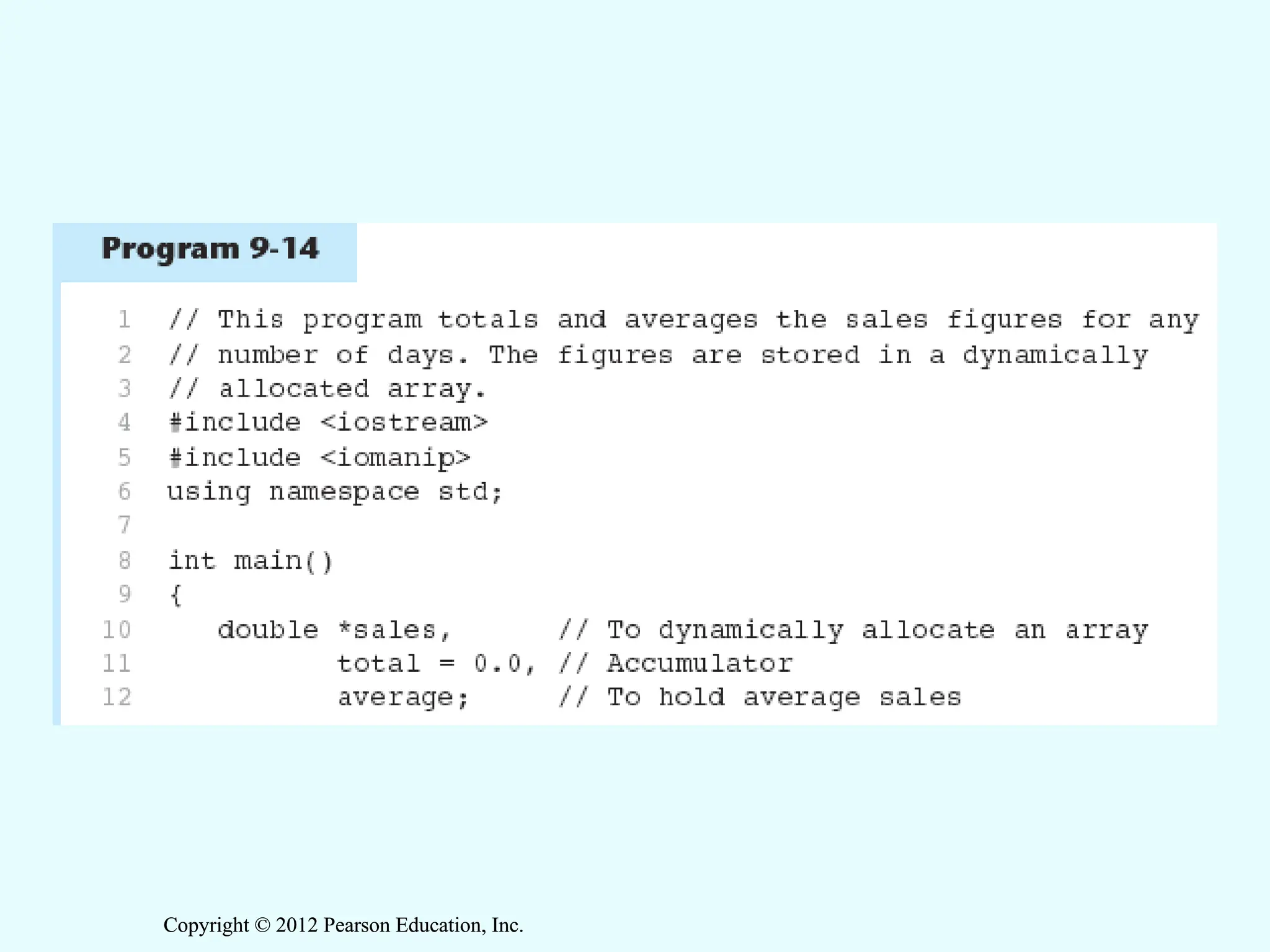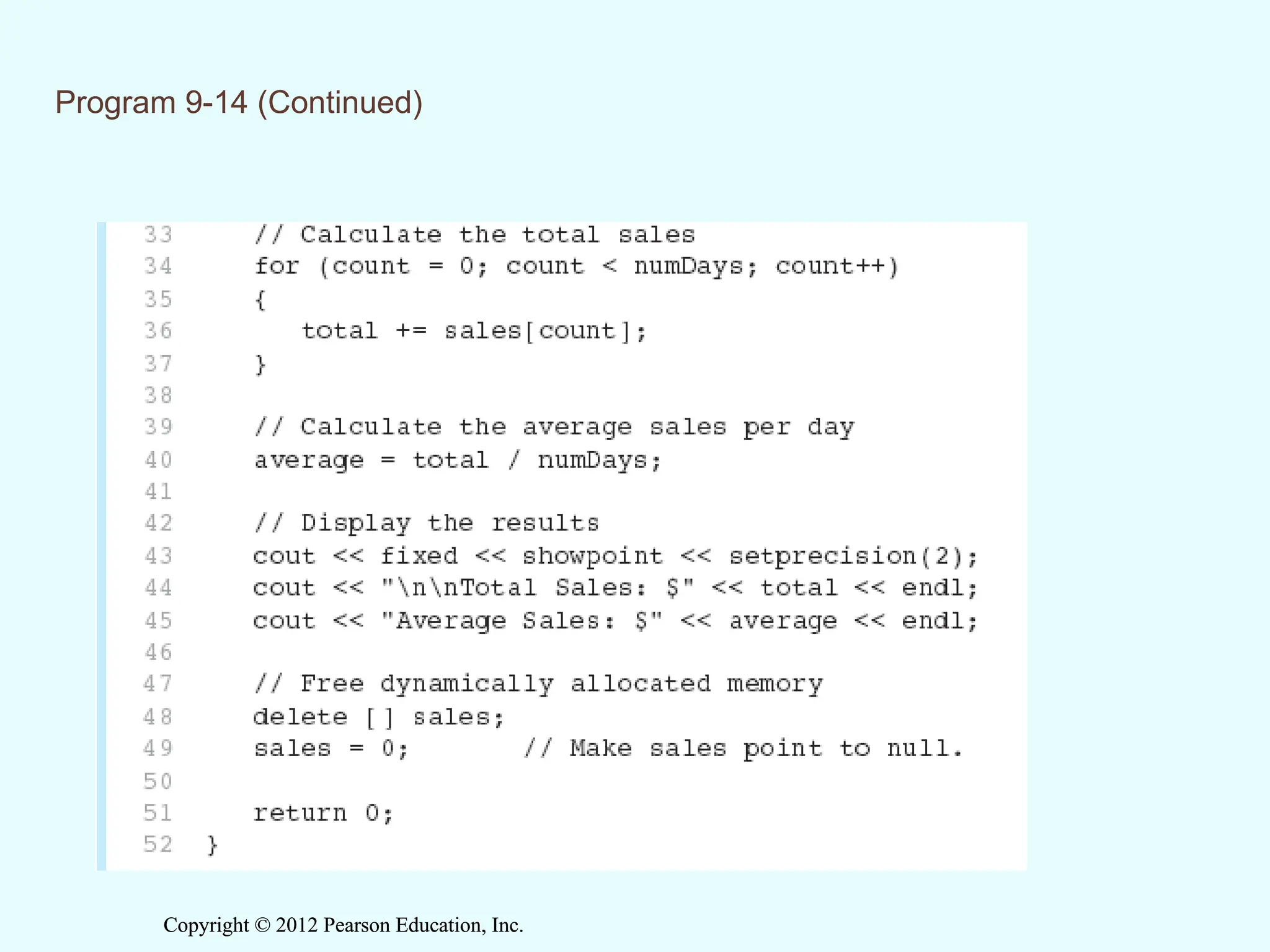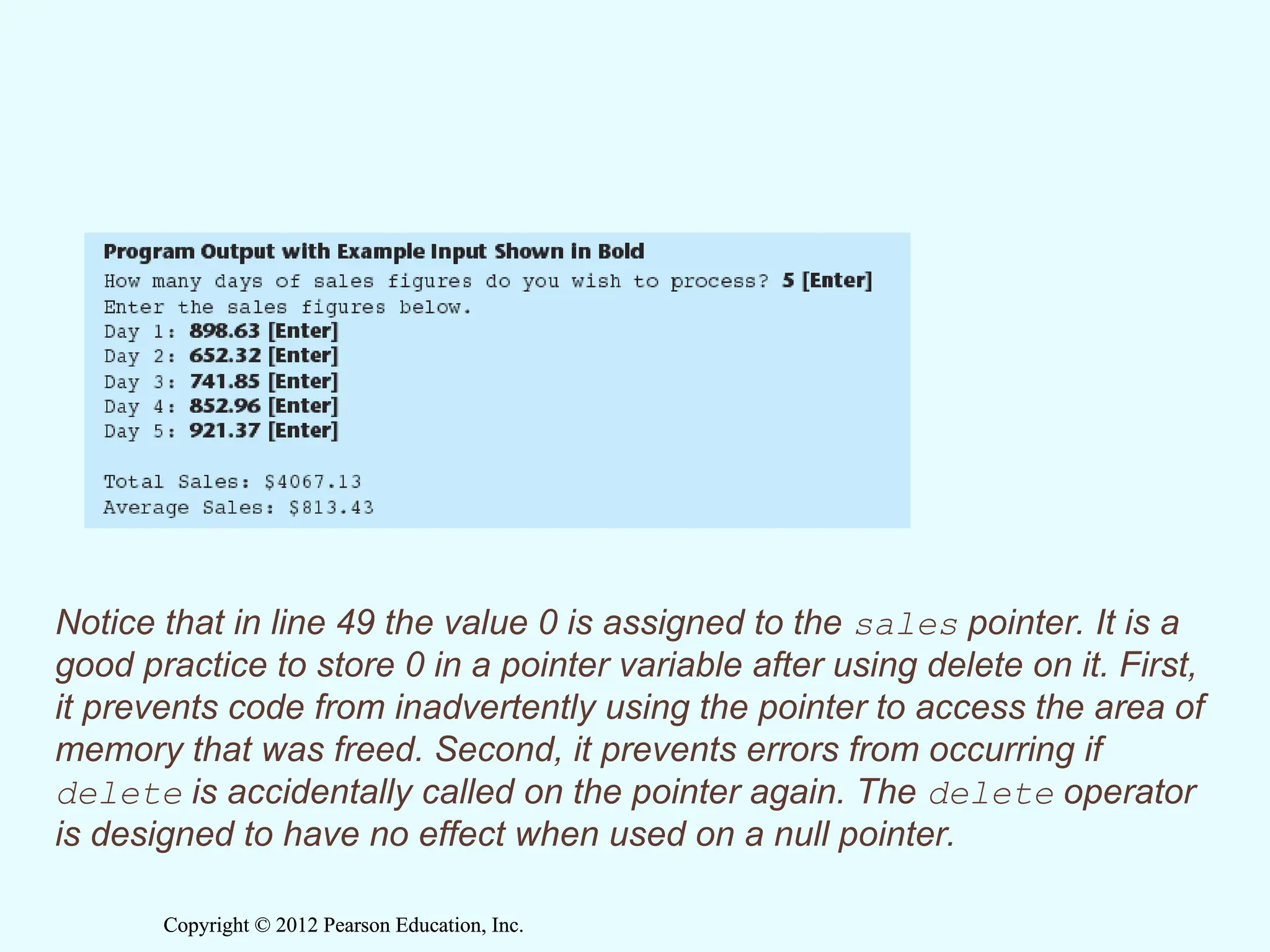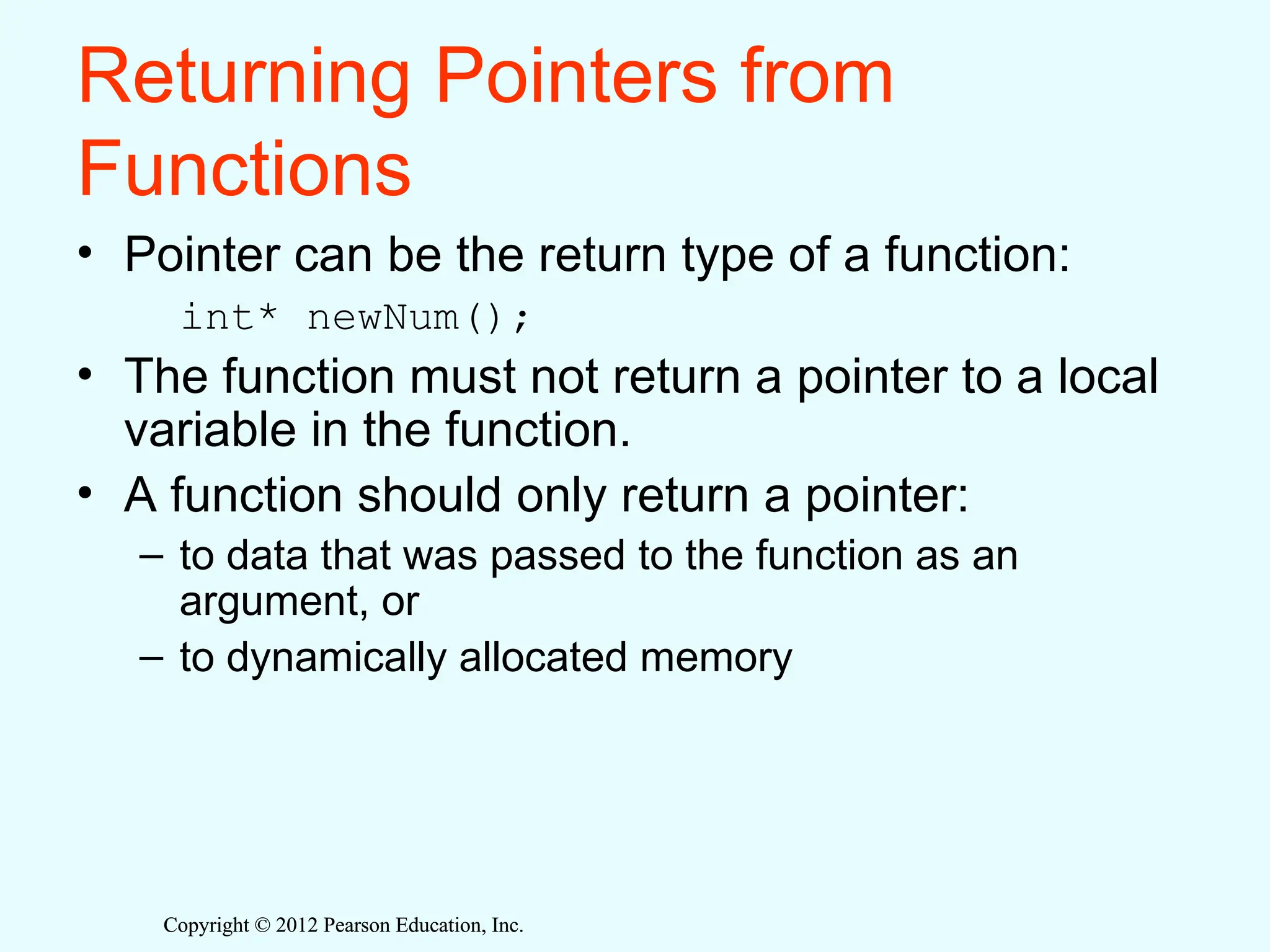More Related Content
Programming in Computer Science- Pointers in C++.ppt Pf cs102 programming-9 [pointers] Computer Programming Lecture numer 05 -- pointers,variablesb Chapter 2 - Introduction to Pointer Variables - Student.pdf Object Oriented Programming using C++: Ch10 Pointers.pptx Similar to C++ Programming Text book Chapter 09 .ppt
C++ computer language chapter 4 pointers.pdf Introduction to pointers in c plus plus . Pointers in C++ object oriented programming C++ Pointer | Introduction to programming Chapter 5 (Part I) - Pointers.pdf (4) cpp automatic arrays_pointers_c-strings Lecture 7_Pointer.pptx FOR EDUCATIONAL PURPOSE Object Oriented Paradighm programming lecture .pptx C++ - UNIT_-_IV.pptx which contains details about Pointers Pointer in C++_Somesh_Kumar_Dewangan_SSTC Pointers_in_c.pptfffgfggdggffffrreeeggttr Recently uploaded
Sephora UAE API Service Real-Time Product & Price Data Access.pptx The Future-Ready PMO: Unlocking Project Success with Copilot and AI Innovatio... Configure and Secure SSH - RHCSA (RH124).pdf ENTSO-E's Response to the European Commission Call for Evidence on the Strate... Q3'25 Financial Results and Earnings Presentation Control Access to Files - RHCSA (RH124).pdf Writing GPU-Ready AI Models in Pure Java with Babylon TrustArc Webinar - It’s Time to Rethink Privacy Virtualization and Container Technologies in Cloud Security - ISC2 Certificate Wrapping up unowned UTF8 C strings: CStringView Upskill to Agentic Automation - Working Smarter with AI: Real-World Tools for... GDG Boise - Innovating with Google Cloud Artificial Intelligence Cybersecurity in ASEAN and Singapore Columbia SIPA 2025.pdf From Pixels to Insights: Getting Started with Imagery in FME Revolutionizing SQL Database Design for the Modern Era.pdf PDF Security Intelligence Platform | Cybersecurity Project by Ashish Patil Transparency Exchange API: How Do You Find the SBOM for a Smart Light Bulb? WebXR in Android and Linux with OpenXR Supercharge Your JVM with Project Leyden AWS re:Invent 2025 Event Presentation Slides C++ Programming Text book Chapter 09 .ppt
- 1.
Copyright © 2012Pearson Education, Inc. Copyright © 2012 Pearson Education, Inc. Chapter 9: Pointers - 2.
Copyright © 2012Pearson Education, Inc. Copyright © 2012 Pearson Education, Inc. 9.1 Getting the Address of a Variable - 3.
Copyright © 2012Pearson Education, Inc. Copyright © 2012 Pearson Education, Inc. Getting the Address of a Variable • Each variable in program is stored at a unique address • Use address operator & to get address of a variable: int num = -99; cout << # // prints address // in hexadecimal - 4.
Copyright © 2012Pearson Education, Inc. Copyright © 2012 Pearson Education, Inc. 9.2 Pointer Variables - 5.
Copyright © 2012Pearson Education, Inc. Copyright © 2012 Pearson Education, Inc. Pointer Variables • Pointer variable : Often just called a pointer, it's a variable that holds an address • Because a pointer variable holds the address of another piece of data, it "points" to the data - 6.
Copyright © 2012Pearson Education, Inc. Copyright © 2012 Pearson Education, Inc. Something Like Pointers: Arrays • We have already worked with something similar to pointers, when we learned to pass arrays as arguments to functions. • For example, suppose we use this statement to pass the array numbers to the showValues function: showValues(numbers, SIZE); - 7.
Copyright © 2012Pearson Education, Inc. Copyright © 2012 Pearson Education, Inc. Something Like Pointers : Arrays The values parameter, in the showValues function, points to the numbers array. C++ automatically stores the address of numbers in the values parameter. - 8.
Copyright © 2012Pearson Education, Inc. Copyright © 2012 Pearson Education, Inc. Something Like Pointers: Reference Variables • We have also worked with something like pointers when we learned to use reference variables. Suppose we have this function: void getOrder(int &donuts) { cout << "How many doughnuts do you want? "; cin >> donuts; } • And we call it with this code: int jellyDonuts; getOrder(jellyDonuts); - 9.
Copyright © 2012Pearson Education, Inc. Copyright © 2012 Pearson Education, Inc. Something Like Pointers: Reference Variables The donuts parameter, in the getOrder function, points to the jellyDonuts variable. C++ automatically stores the address of jellyDonuts in the donuts parameter. - 10.
Copyright © 2012Pearson Education, Inc. Copyright © 2012 Pearson Education, Inc. Pointer Variables • Pointer variables are yet another way using a memory address to work with a piece of data. • Pointers are more "low-level" than arrays and reference variables. • This means you are responsible for finding the address you want to store in the pointer and correctly using it. - 11.
Copyright © 2012Pearson Education, Inc. Copyright © 2012 Pearson Education, Inc. Pointer Variables • Definition: int *intptr; • Read as: “intptr can hold the address of an int” • Spacing in definition does not matter: int * intptr; // same as above int* intptr; // same as above - 12.
Copyright © 2012Pearson Education, Inc. Copyright © 2012 Pearson Education, Inc. Pointer Variables • Assigning an address to a pointer variable: int *intptr; intptr = # • Memory layout: num intptr 25 0x4a00 address of num: 0x4a00 - 13.
Copyright © 2012Pearson Education, Inc. Copyright © 2012 Pearson Education, Inc. - 14.
Copyright © 2012Pearson Education, Inc. Copyright © 2012 Pearson Education, Inc. The Indirection Operator • The indirection operator (*) dereferences a pointer. • It allows you to access the item that the pointer points to. int x = 25; int *intptr = &x; cout << *intptr << endl; This prints 25. - 15.
Copyright © 2012Pearson Education, Inc. Copyright © 2012 Pearson Education, Inc. - 16.
Copyright © 2012Pearson Education, Inc. Copyright © 2012 Pearson Education, Inc. 9-16 - 17.
Copyright © 2012Pearson Education, Inc. Copyright © 2012 Pearson Education, Inc. 9.3 The Relationship Between Arrays and Pointers - 18.
Copyright © 2012Pearson Education, Inc. Copyright © 2012 Pearson Education, Inc. The Relationship Between Arrays and Pointers • Array name is starting address of array int vals[] = {4, 7, 11}; cout << vals; // displays // 0x4a00 cout << vals[0]; // displays 4 4 7 11 starting address of vals: 0x4a00 - 19.
Copyright © 2012Pearson Education, Inc. Copyright © 2012 Pearson Education, Inc. The Relationship Between Arrays and Pointers • Array name can be used as a pointer constant: int vals[] = {4, 7, 11}; cout << *vals; // displays 4 • Pointer can be used as an array name: int *valptr = vals; cout << valptr[1]; // displays 7 - 20.
Copyright © 2012Pearson Education, Inc. Copyright © 2012 Pearson Education, Inc. 9-20 - 21.
Copyright © 2012Pearson Education, Inc. Copyright © 2012 Pearson Education, Inc. Pointers in Expressions Given: int vals[]={4,7,11}, *valptr; valptr = vals; What is valptr + 1? It means (address in valptr) + (1 * size of an int) cout << *(valptr+1); //displays 7 cout << *(valptr+2); //displays 11 Must use ( ) as shown in the expressions - 22.
Copyright © 2012Pearson Education, Inc. Copyright © 2012 Pearson Education, Inc. Array Access • Array elements can be accessed in many ways: Array access method Example array name and [] vals[2] = 17; pointer to array and [] valptr[2] = 17; array name and subscript arithmetic *(vals + 2) = 17; pointer to array and subscript arithmetic *(valptr + 2) = 17; - 23.
Copyright © 2012Pearson Education, Inc. Copyright © 2012 Pearson Education, Inc. Array Access • Conversion: vals[i] is equivalent to *(vals + i) • No bounds checking performed on array access, whether using array name or a pointer - 24.
Copyright © 2012Pearson Education, Inc. Copyright © 2012 Pearson Education, Inc. From Program 9-7 - 25.
Copyright © 2012Pearson Education, Inc. Copyright © 2012 Pearson Education, Inc. 9.4 Pointer Arithmetic - 26.
Copyright © 2012Pearson Education, Inc. Copyright © 2012 Pearson Education, Inc. Pointer Arithmetic • Operations on pointer variables: 9-26 Operation Example int vals[]={4,7,11}; int *valptr = vals; ++, -- valptr++; // points at 7 valptr--; // now points at 4 +, - (pointer and int) cout << *(valptr + 2); // 11 +=, -= (pointer and int) valptr = vals; // points at 4 valptr += 2; // points at 11 - (pointer from pointer) cout << valptr–val; // difference //(number of ints) between valptr // and val - 27.
Copyright © 2012Pearson Education, Inc. Copyright © 2012 Pearson Education, Inc. From Program 9-9 - 28.
Copyright © 2012Pearson Education, Inc. Copyright © 2012 Pearson Education, Inc. 9.5 Initializing Pointers - 29.
Copyright © 2012Pearson Education, Inc. Copyright © 2012 Pearson Education, Inc. Initializing Pointers • Can initialize at definition time: int num, *numptr = # int val[3], *valptr = val; • Cannot mix data types: double cost; int *ptr = &cost; // won’t work • Can test for an invalid address for ptr with: if (!ptr) ... - 30.
Copyright © 2012Pearson Education, Inc. Copyright © 2012 Pearson Education, Inc. 9.6 Comparing Pointers - 31.
Copyright © 2012Pearson Education, Inc. Copyright © 2012 Pearson Education, Inc. Comparing Pointers • Relational operators (<, >=, etc.) can be used to compare addresses in pointers • Comparing addresses in pointers is not the same as comparing contents pointed at by pointers: if (ptr1 == ptr2) // compares // addresses if (*ptr1 == *ptr2) // compares // contents 9-31 - 32.
Copyright © 2012Pearson Education, Inc. Copyright © 2012 Pearson Education, Inc. 9.7 Pointers as Function Parameters - 33.
Copyright © 2012Pearson Education, Inc. Copyright © 2012 Pearson Education, Inc. Pointers as Function Parameters • A pointer can be a parameter • Works like reference variable to allow change to argument from within function • Requires: 1) asterisk * on parameter in prototype and heading void getNum(int *ptr); // ptr is pointer to an int 2) asterisk * in body to dereference the pointer cin >> *ptr; 3) address as argument to the function getNum(&num); // pass address of num to getNum - 34.
Copyright © 2012Pearson Education, Inc. Copyright © 2012 Pearson Education, Inc. Example void swap(int *x, int *y) { int temp; temp = *x; *x = *y; *y = temp; } int num1 = 2, num2 = -3; swap(&num1, &num2); - 35.
Copyright © 2012Pearson Education, Inc. Copyright © 2012 Pearson Education, Inc. (Program Continues) - 36.
Copyright © 2012Pearson Education, Inc. Copyright © 2012 Pearson Education, Inc. - 37.
Copyright © 2012Pearson Education, Inc. Copyright © 2012 Pearson Education, Inc. Pointers to Constants • If we want to store the address of a constant in a pointer, then we need to store it in a pointer-to-const. - 38.
Copyright © 2012Pearson Education, Inc. Copyright © 2012 Pearson Education, Inc. Pointers to Constants • Example: Suppose we have the following definitions: const int SIZE = 6; const double payRates[SIZE] = { 18.55, 17.45, 12.85, 14.97, 10.35, 18.89 }; • In this code, payRates is an array of constant doubles. 9-38 - 39.
Copyright © 2012Pearson Education, Inc. Copyright © 2012 Pearson Education, Inc. Pointers to Constants • Suppose we wish to pass the payRates array to a function? Here's an example of how we can do it. void displayPayRates(const double *rates, int size) { for (int count = 0; count < size; count++) { cout << "Pay rate for employee " << (count + 1) << " is $" << *(rates + count) << endl; } } The parameter, rates, is a pointer to const double. - 40.
Copyright © 2012Pearson Education, Inc. Copyright © 2012 Pearson Education, Inc. Declaration of a Pointer to Constant - 41.
Copyright © 2012Pearson Education, Inc. Copyright © 2012 Pearson Education, Inc. Constant Pointers • A constant pointer is a pointer that is initialized with an address, and cannot point to anything else. • Example int value = 22; int * const ptr = &value; - 42.
Copyright © 2012Pearson Education, Inc. Copyright © 2012 Pearson Education, Inc. Constant Pointers - 43.
Copyright © 2012Pearson Education, Inc. Copyright © 2012 Pearson Education, Inc. Constant Pointers to Constants • A constant pointer to a constant is: – a pointer that points to a constant – a pointer that cannot point to anything except what it is pointing to • Example: int value = 22; const int * const ptr = &value; - 44.
Copyright © 2012Pearson Education, Inc. Copyright © 2012 Pearson Education, Inc. Constant Pointers to Constants - 45.
Copyright © 2012Pearson Education, Inc. Copyright © 2012 Pearson Education, Inc. 9.8 Dynamic Memory Allocation - 46.
Copyright © 2012Pearson Education, Inc. Copyright © 2012 Pearson Education, Inc. Dynamic Memory Allocation • Can allocate storage for a variable while program is running • Computer returns address of newly allocated variable • Uses new operator to allocate memory: double *dptr; dptr = new double; • new returns address of memory location - 47.
Copyright © 2012Pearson Education, Inc. Copyright © 2012 Pearson Education, Inc. Dynamic Memory Allocation • Can also use new to allocate array: const int SIZE = 25; arrayPtr = new double[SIZE]; • Can then use [] or pointer arithmetic to access array: for(i = 0; i < SIZE; i++) *arrayptr[i] = i * i; or for(i = 0; i < SIZE; i++) *(arrayptr + i) = i * i; • Program will terminate if not enough memory available to allocate - 48.
Copyright © 2012Pearson Education, Inc. Copyright © 2012 Pearson Education, Inc. Releasing Dynamic Memory • Use delete to free dynamic memory: delete fptr; • Use [] to free dynamic array: delete [] arrayptr; • Only use delete with dynamic memory! - 49.
Copyright © 2012Pearson Education, Inc. Copyright © 2012 Pearson Education, Inc. - 50.
Copyright © 2012Pearson Education, Inc. Copyright © 2012 Pearson Education, Inc. - 51.
Copyright © 2012Pearson Education, Inc. Copyright © 2012 Pearson Education, Inc. Program 9-14 (Continued) - 52.
Copyright © 2012Pearson Education, Inc. Copyright © 2012 Pearson Education, Inc. Notice that in line 49 the value 0 is assigned to the sales pointer. It is a good practice to store 0 in a pointer variable after using delete on it. First, it prevents code from inadvertently using the pointer to access the area of memory that was freed. Second, it prevents errors from occurring if delete is accidentally called on the pointer again. The delete operator is designed to have no effect when used on a null pointer. - 53.
Copyright © 2012Pearson Education, Inc. Copyright © 2012 Pearson Education, Inc. 9.9 Returning Pointers from Functions - 54.
Copyright © 2012Pearson Education, Inc. Copyright © 2012 Pearson Education, Inc. Returning Pointers from Functions • Pointer can be the return type of a function: int* newNum(); • The function must not return a pointer to a local variable in the function. • A function should only return a pointer: – to data that was passed to the function as an argument, or – to dynamically allocated memory - 55.
Copyright © 2012Pearson Education, Inc. Copyright © 2012 Pearson Education, Inc. From Program 9-15

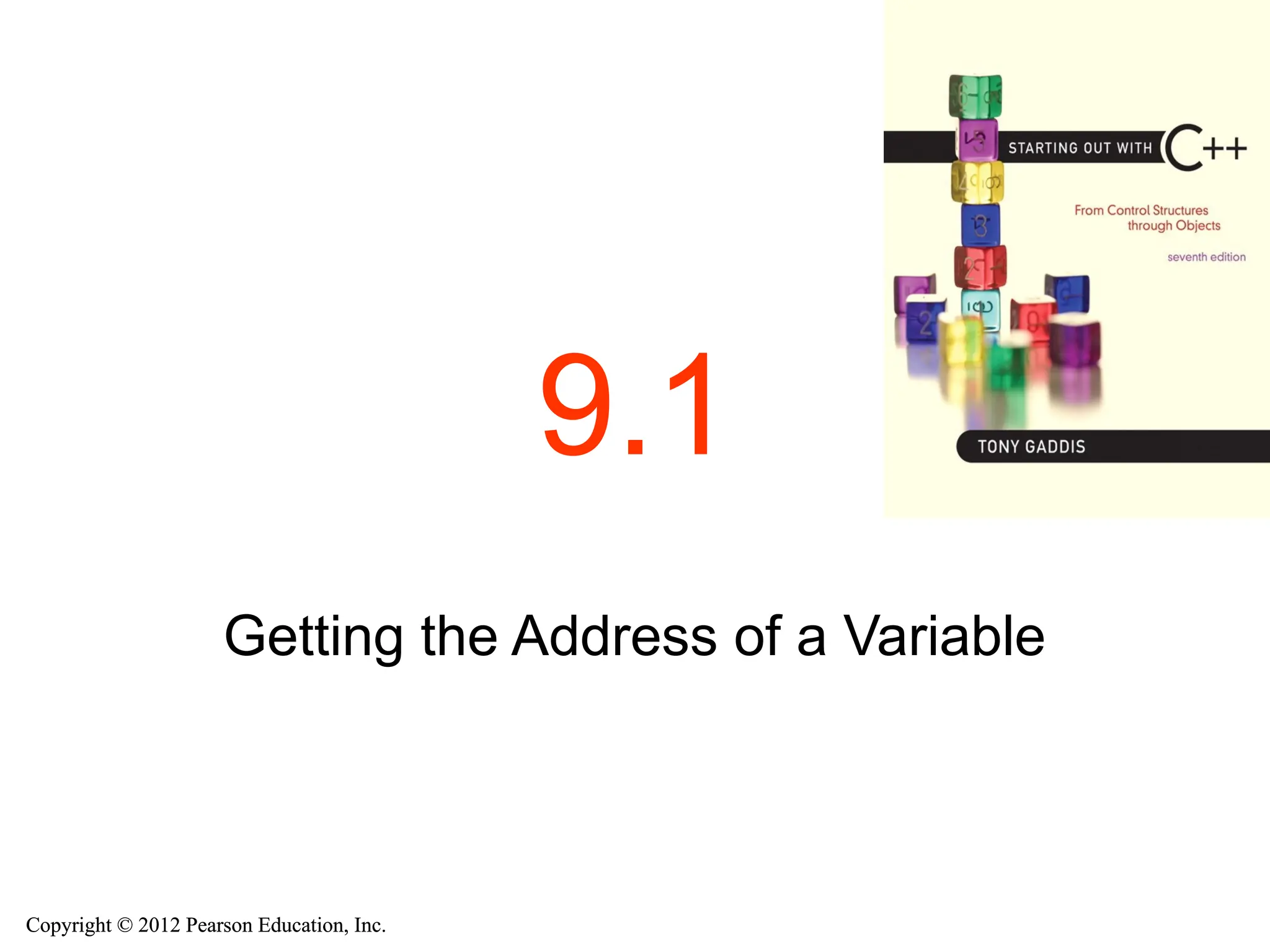

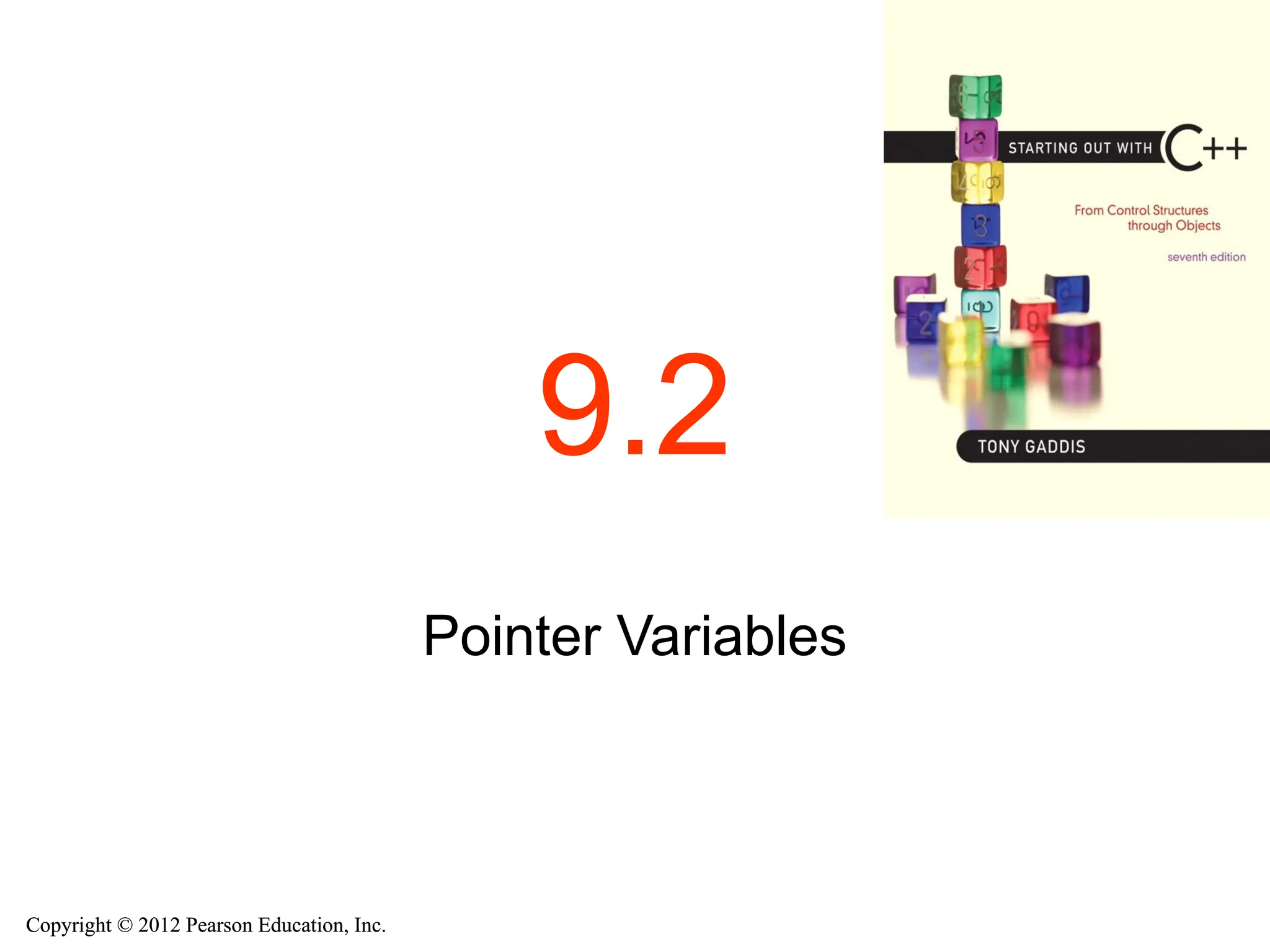
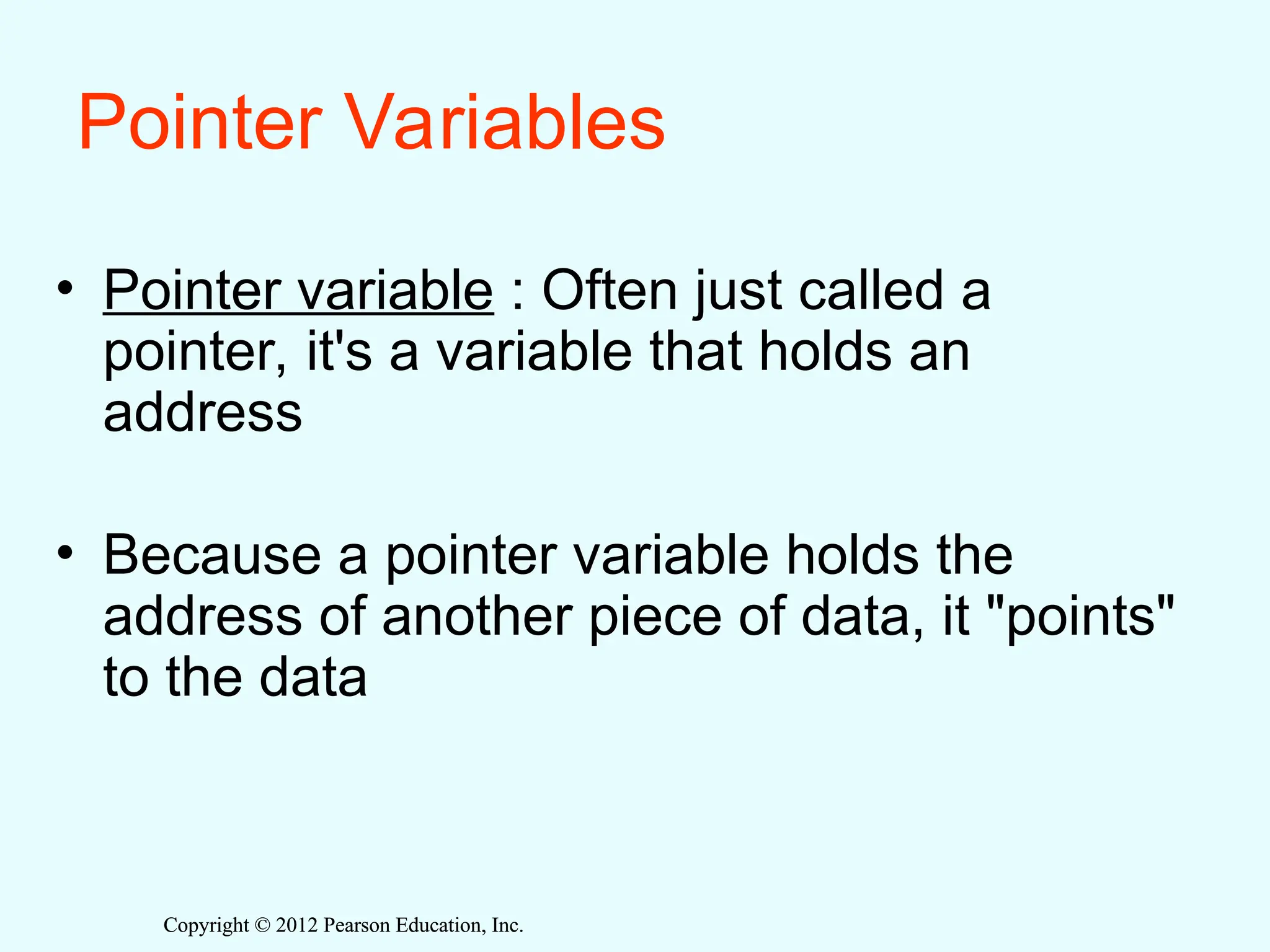
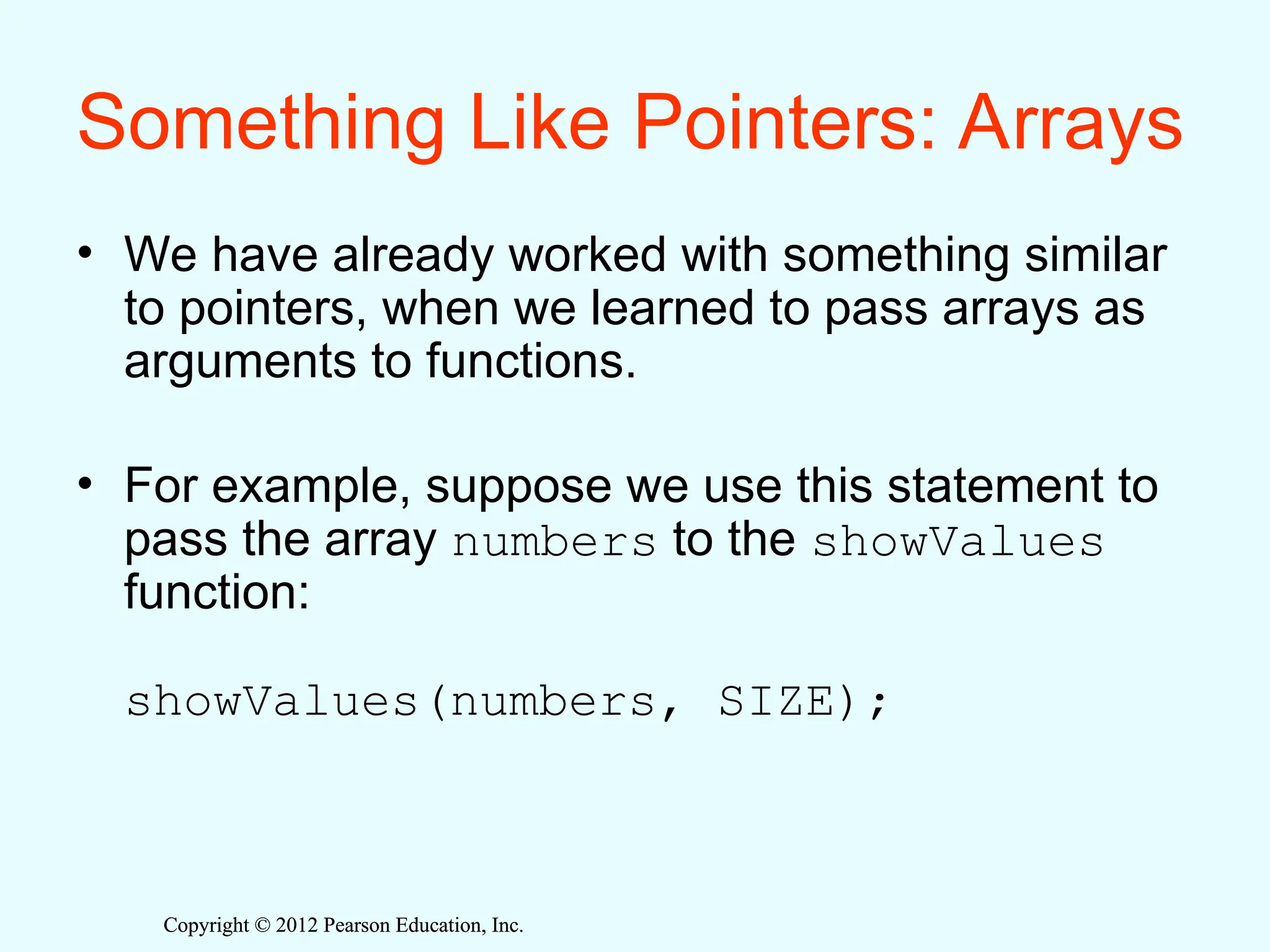
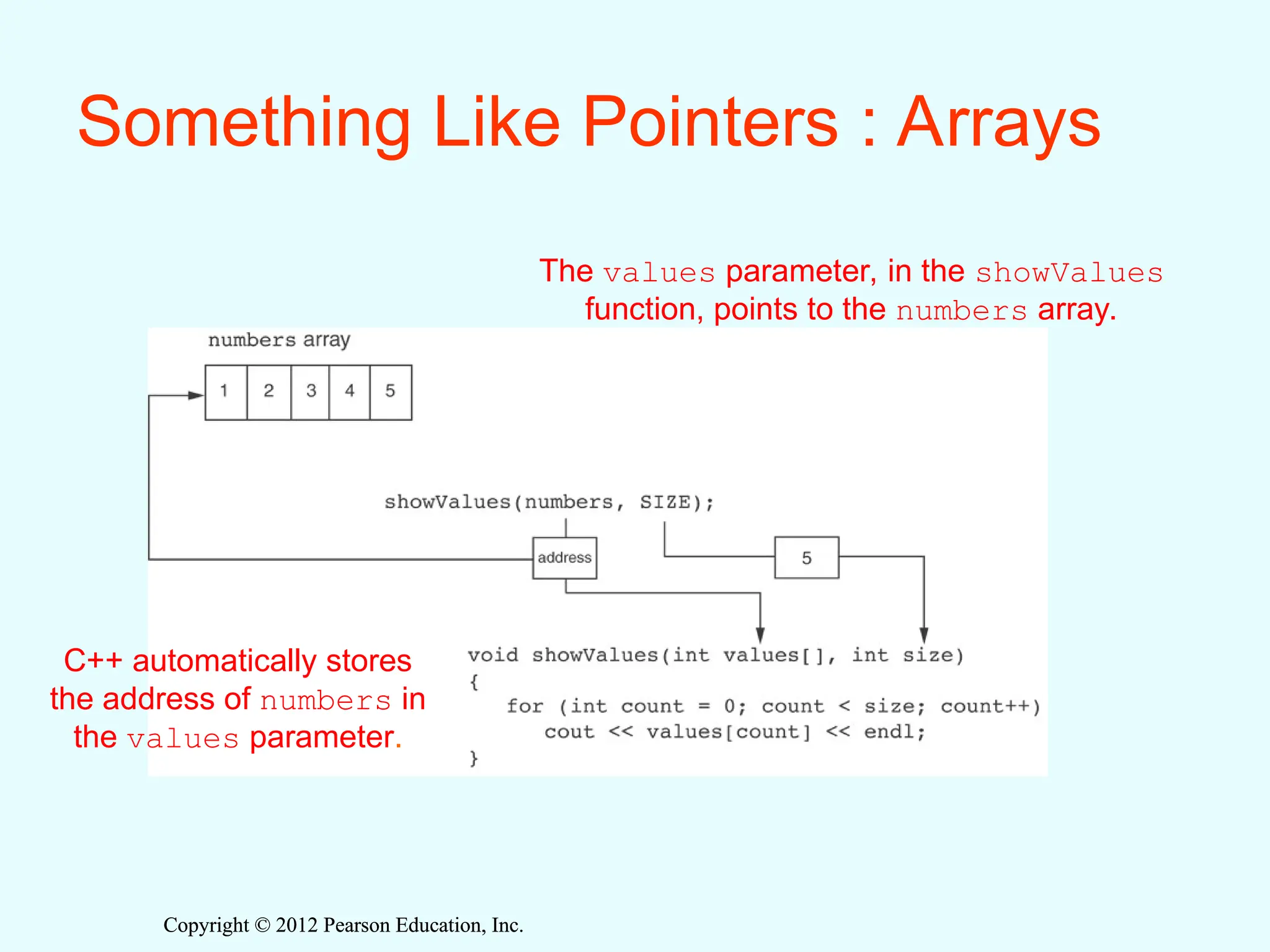
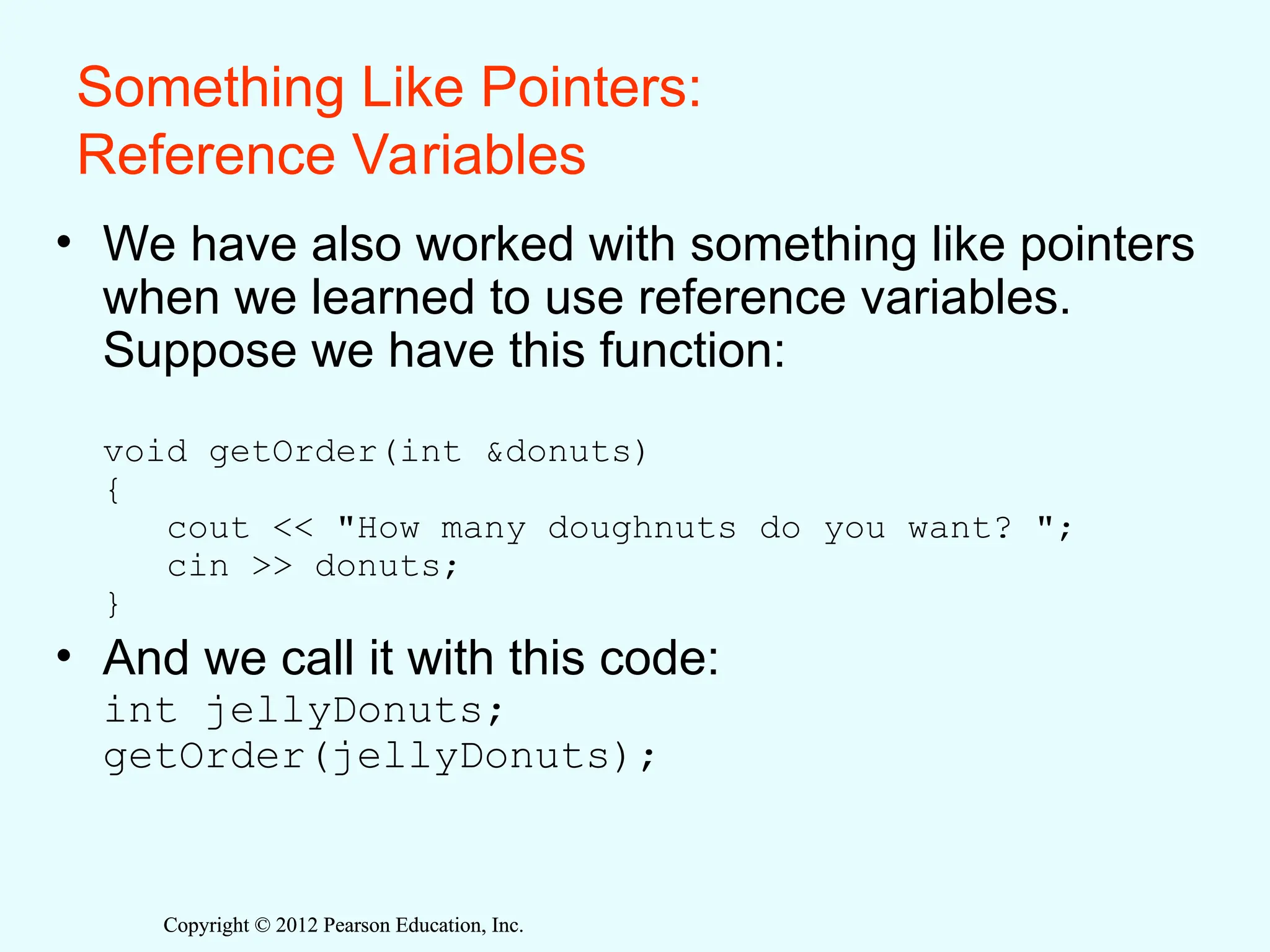

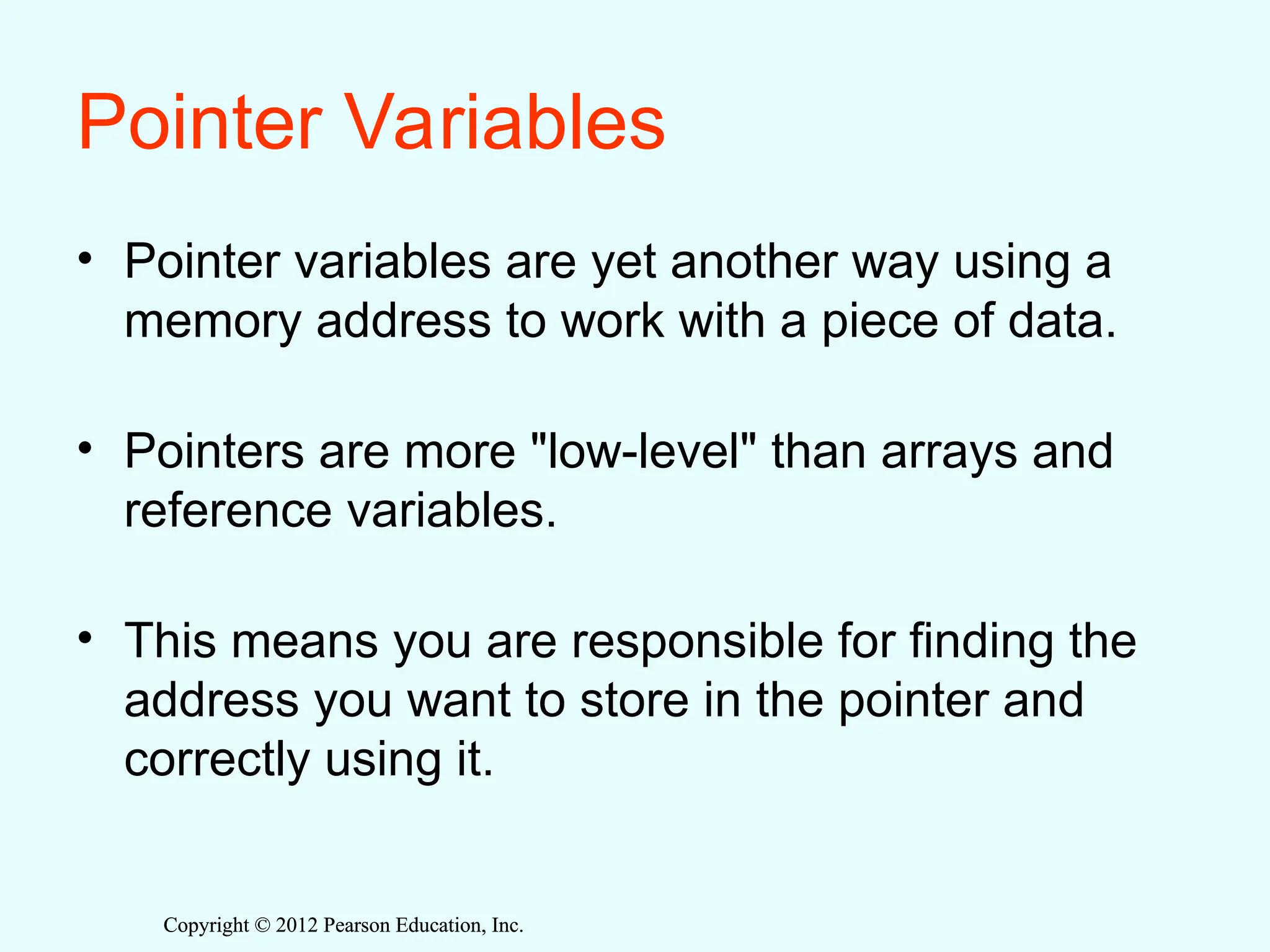
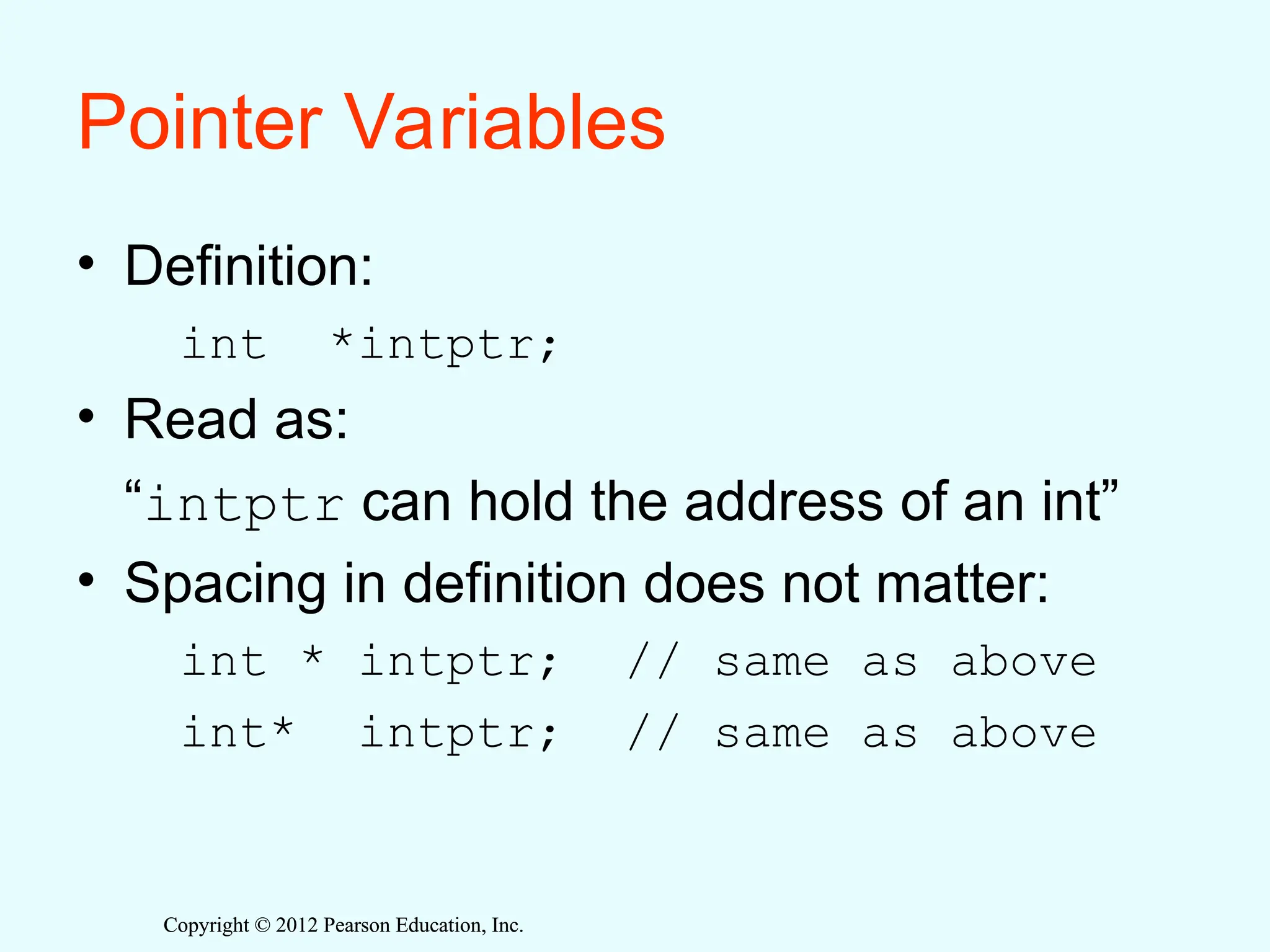
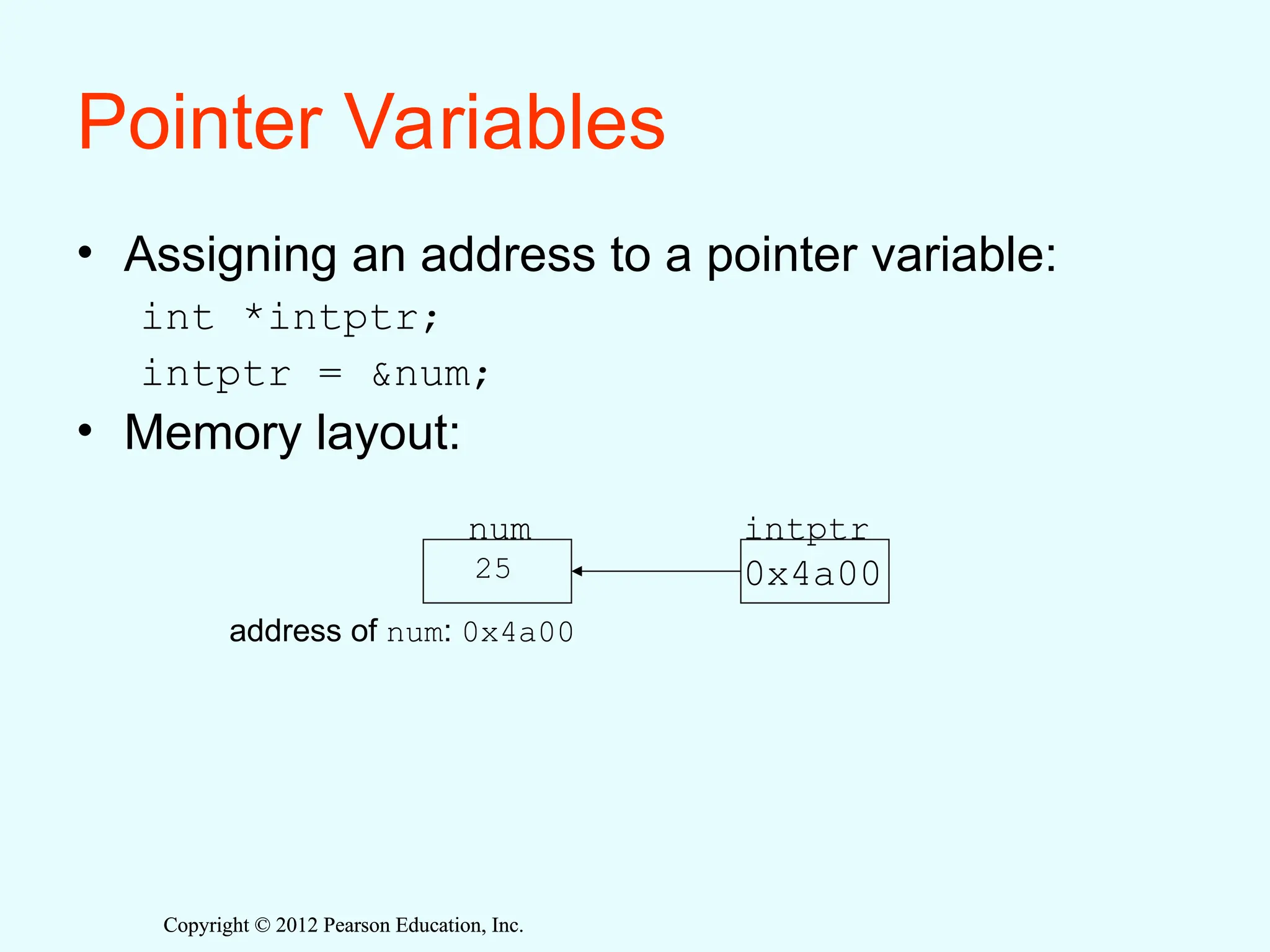


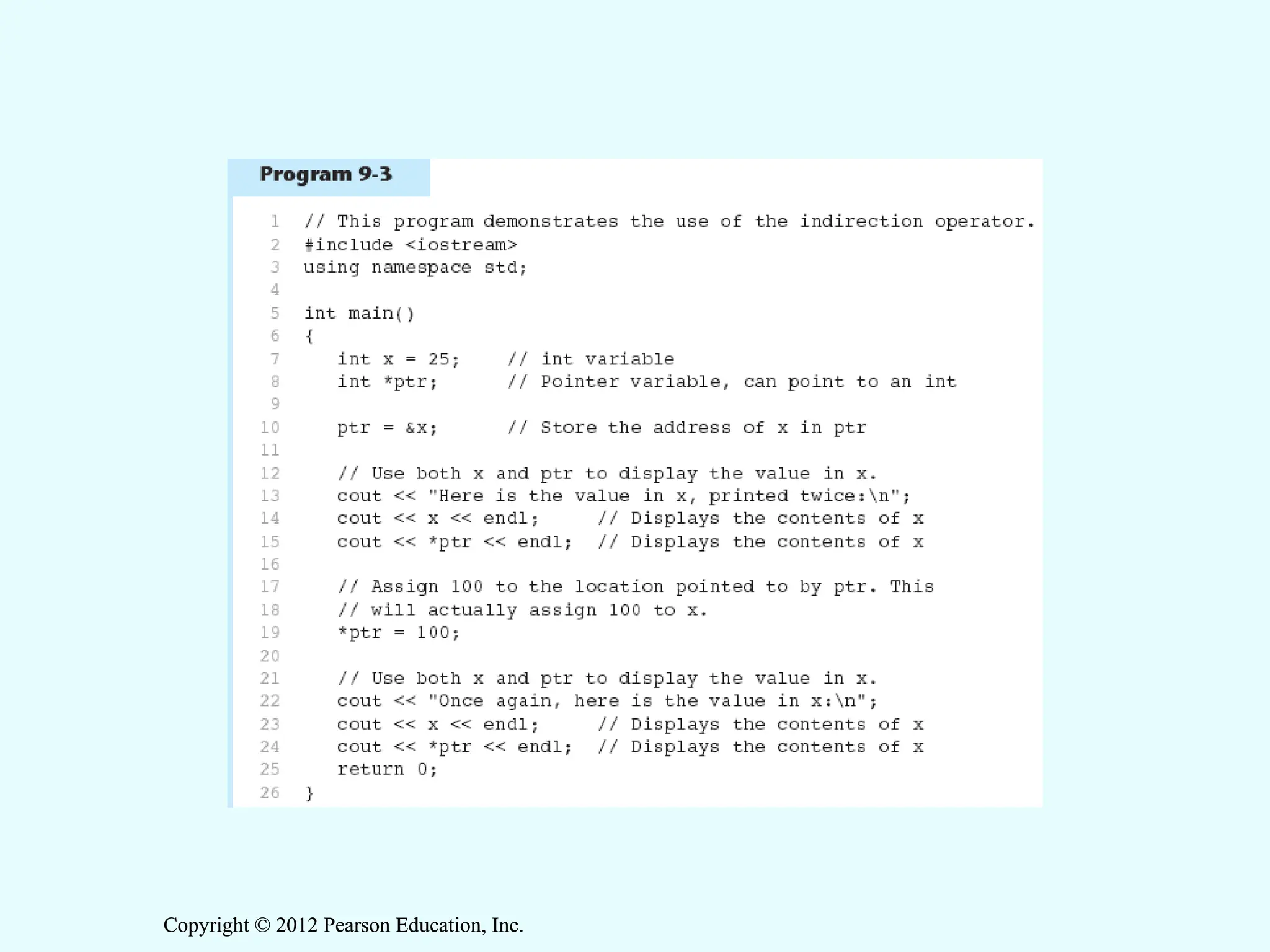

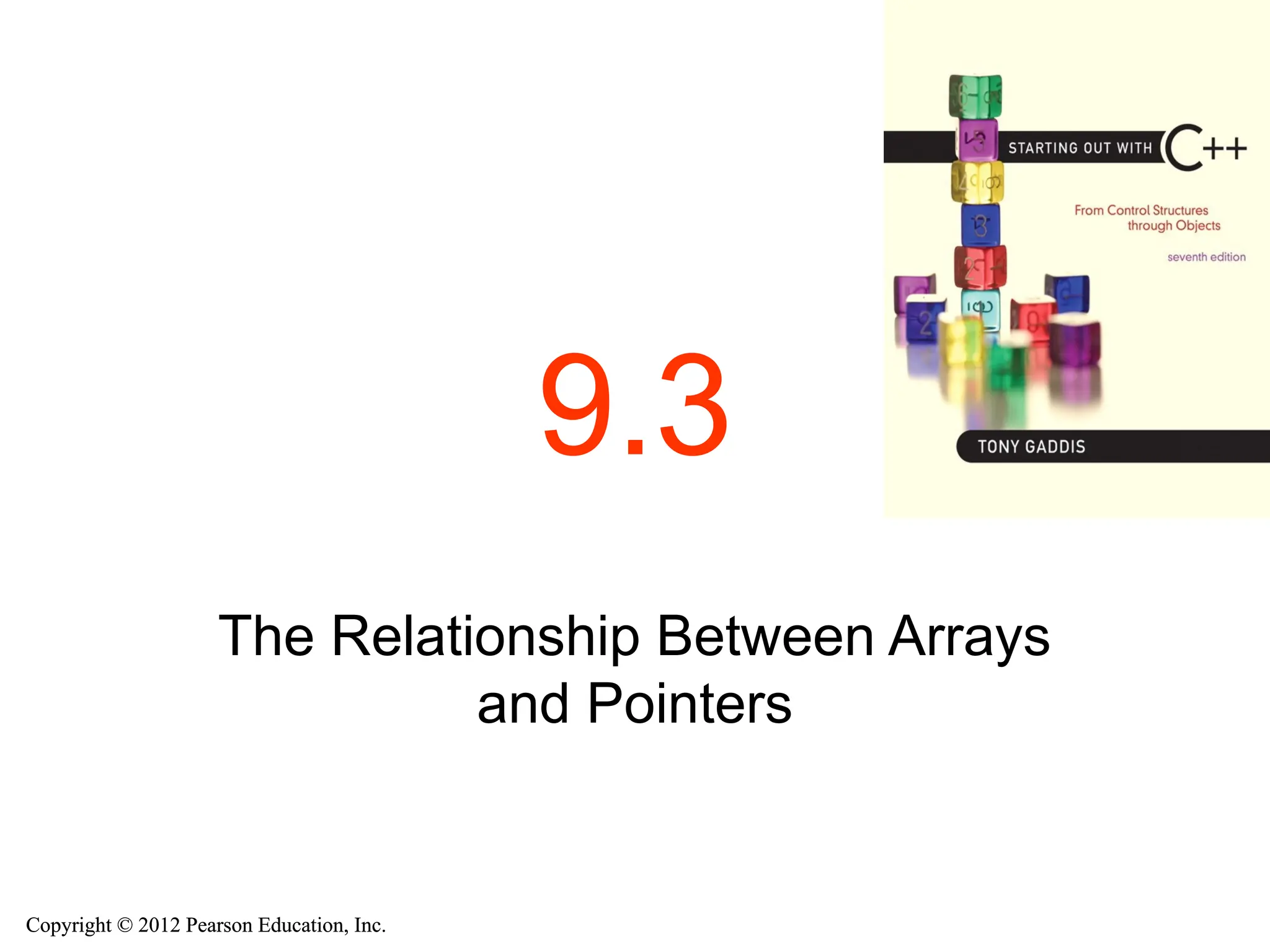
![Copyright © 2012 Pearson Education, Inc. Copyright © 2012 Pearson Education, Inc. The Relationship Between Arrays and Pointers • Array name is starting address of array int vals[] = {4, 7, 11}; cout << vals; // displays // 0x4a00 cout << vals[0]; // displays 4 4 7 11 starting address of vals: 0x4a00](https://image.slidesharecdn.com/chapter09-250922172301-bbf49916/75/C-Programming-Text-book-Chapter-09-ppt-18-2048.jpg)
![Copyright © 2012 Pearson Education, Inc. Copyright © 2012 Pearson Education, Inc. The Relationship Between Arrays and Pointers • Array name can be used as a pointer constant: int vals[] = {4, 7, 11}; cout << *vals; // displays 4 • Pointer can be used as an array name: int *valptr = vals; cout << valptr[1]; // displays 7](https://image.slidesharecdn.com/chapter09-250922172301-bbf49916/75/C-Programming-Text-book-Chapter-09-ppt-19-2048.jpg)
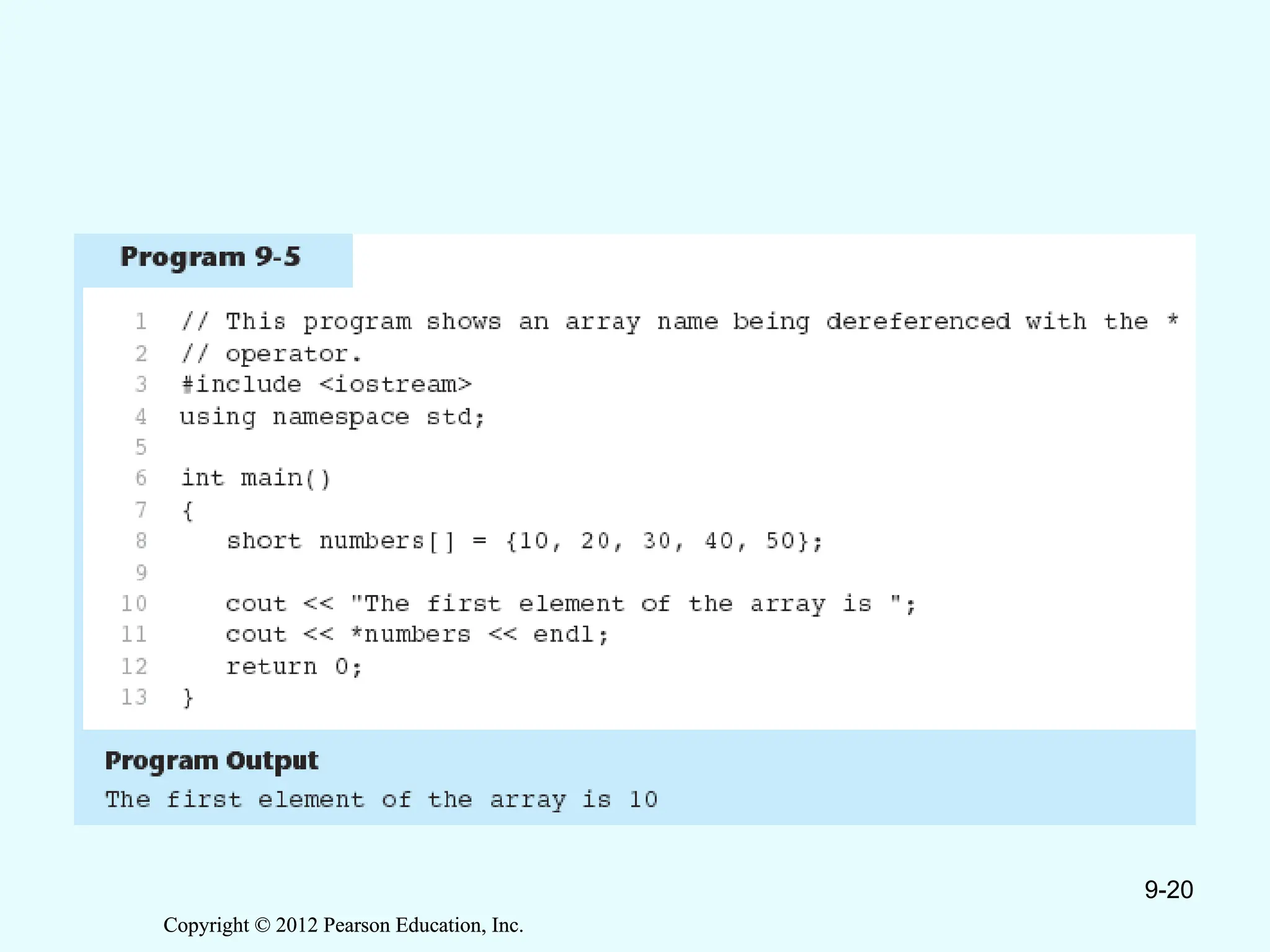
![Copyright © 2012 Pearson Education, Inc. Copyright © 2012 Pearson Education, Inc. Pointers in Expressions Given: int vals[]={4,7,11}, *valptr; valptr = vals; What is valptr + 1? It means (address in valptr) + (1 * size of an int) cout << *(valptr+1); //displays 7 cout << *(valptr+2); //displays 11 Must use ( ) as shown in the expressions](https://image.slidesharecdn.com/chapter09-250922172301-bbf49916/75/C-Programming-Text-book-Chapter-09-ppt-21-2048.jpg)
![Copyright © 2012 Pearson Education, Inc. Copyright © 2012 Pearson Education, Inc. Array Access • Array elements can be accessed in many ways: Array access method Example array name and [] vals[2] = 17; pointer to array and [] valptr[2] = 17; array name and subscript arithmetic *(vals + 2) = 17; pointer to array and subscript arithmetic *(valptr + 2) = 17;](https://image.slidesharecdn.com/chapter09-250922172301-bbf49916/75/C-Programming-Text-book-Chapter-09-ppt-22-2048.jpg)
![Copyright © 2012 Pearson Education, Inc. Copyright © 2012 Pearson Education, Inc. Array Access • Conversion: vals[i] is equivalent to *(vals + i) • No bounds checking performed on array access, whether using array name or a pointer](https://image.slidesharecdn.com/chapter09-250922172301-bbf49916/75/C-Programming-Text-book-Chapter-09-ppt-23-2048.jpg)
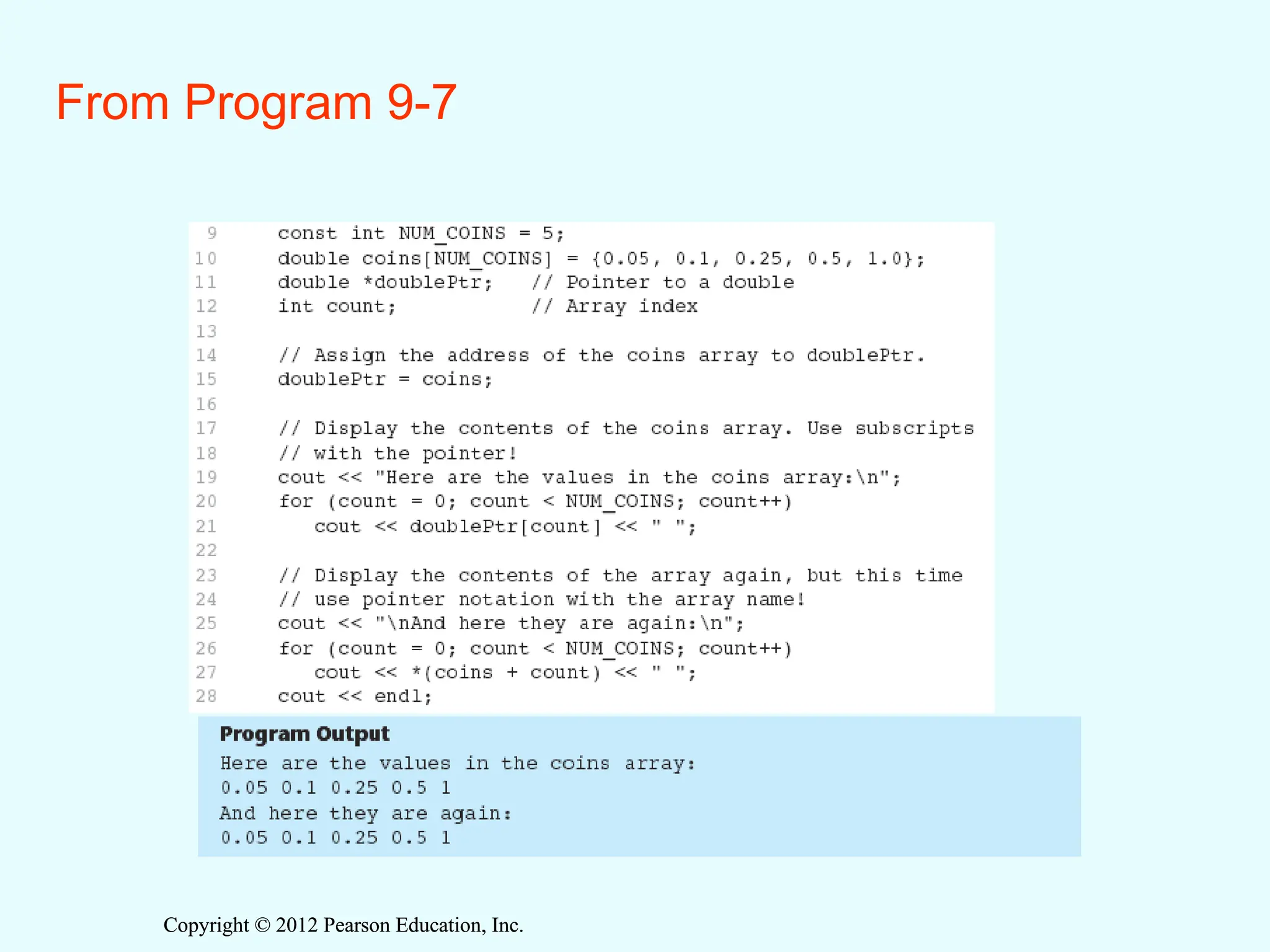

![Copyright © 2012 Pearson Education, Inc. Copyright © 2012 Pearson Education, Inc. Pointer Arithmetic • Operations on pointer variables: 9-26 Operation Example int vals[]={4,7,11}; int *valptr = vals; ++, -- valptr++; // points at 7 valptr--; // now points at 4 +, - (pointer and int) cout << *(valptr + 2); // 11 +=, -= (pointer and int) valptr = vals; // points at 4 valptr += 2; // points at 11 - (pointer from pointer) cout << valptr–val; // difference //(number of ints) between valptr // and val](https://image.slidesharecdn.com/chapter09-250922172301-bbf49916/75/C-Programming-Text-book-Chapter-09-ppt-26-2048.jpg)
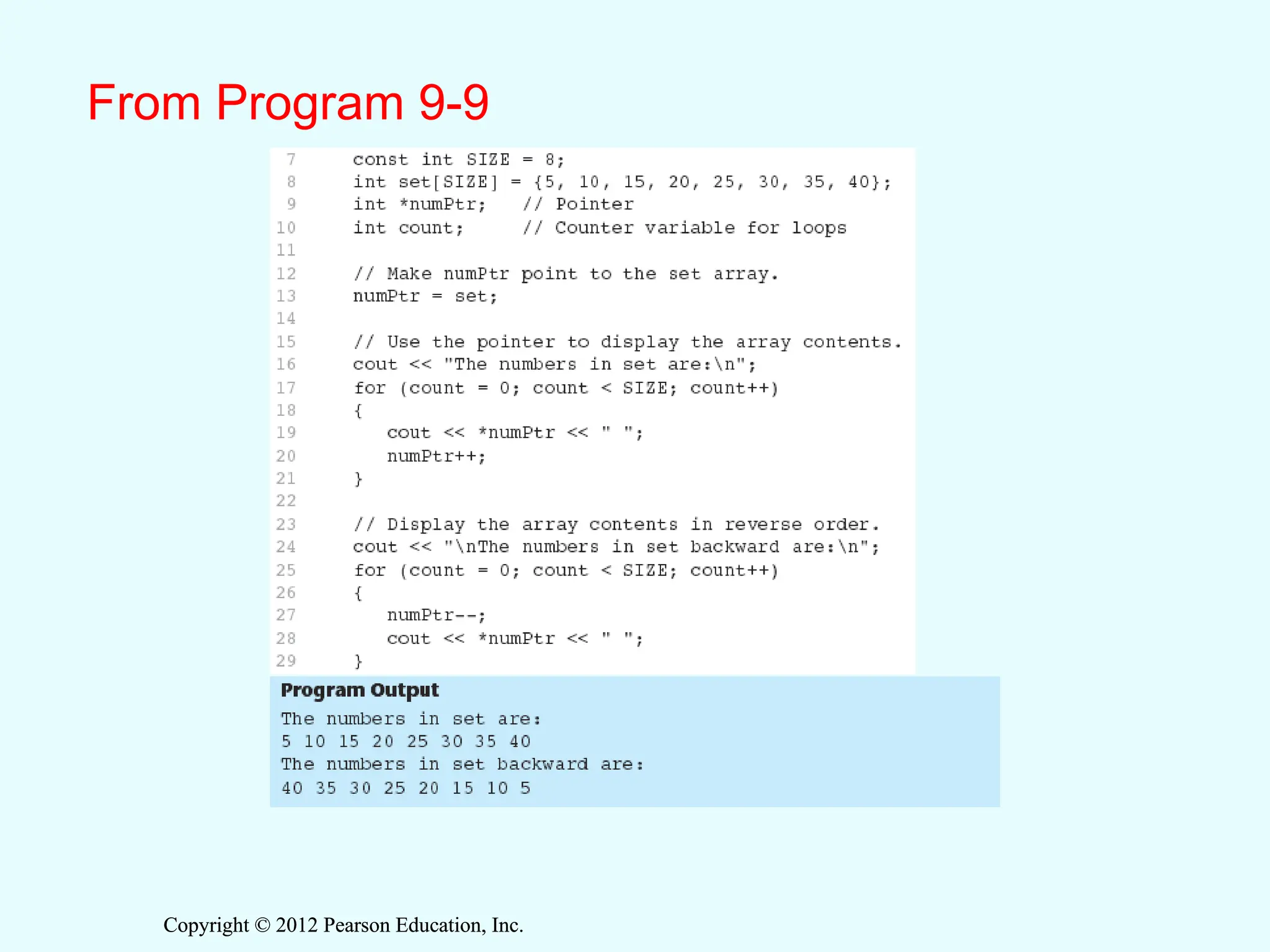

![Copyright © 2012 Pearson Education, Inc. Copyright © 2012 Pearson Education, Inc. Initializing Pointers • Can initialize at definition time: int num, *numptr = # int val[3], *valptr = val; • Cannot mix data types: double cost; int *ptr = &cost; // won’t work • Can test for an invalid address for ptr with: if (!ptr) ...](https://image.slidesharecdn.com/chapter09-250922172301-bbf49916/75/C-Programming-Text-book-Chapter-09-ppt-29-2048.jpg)

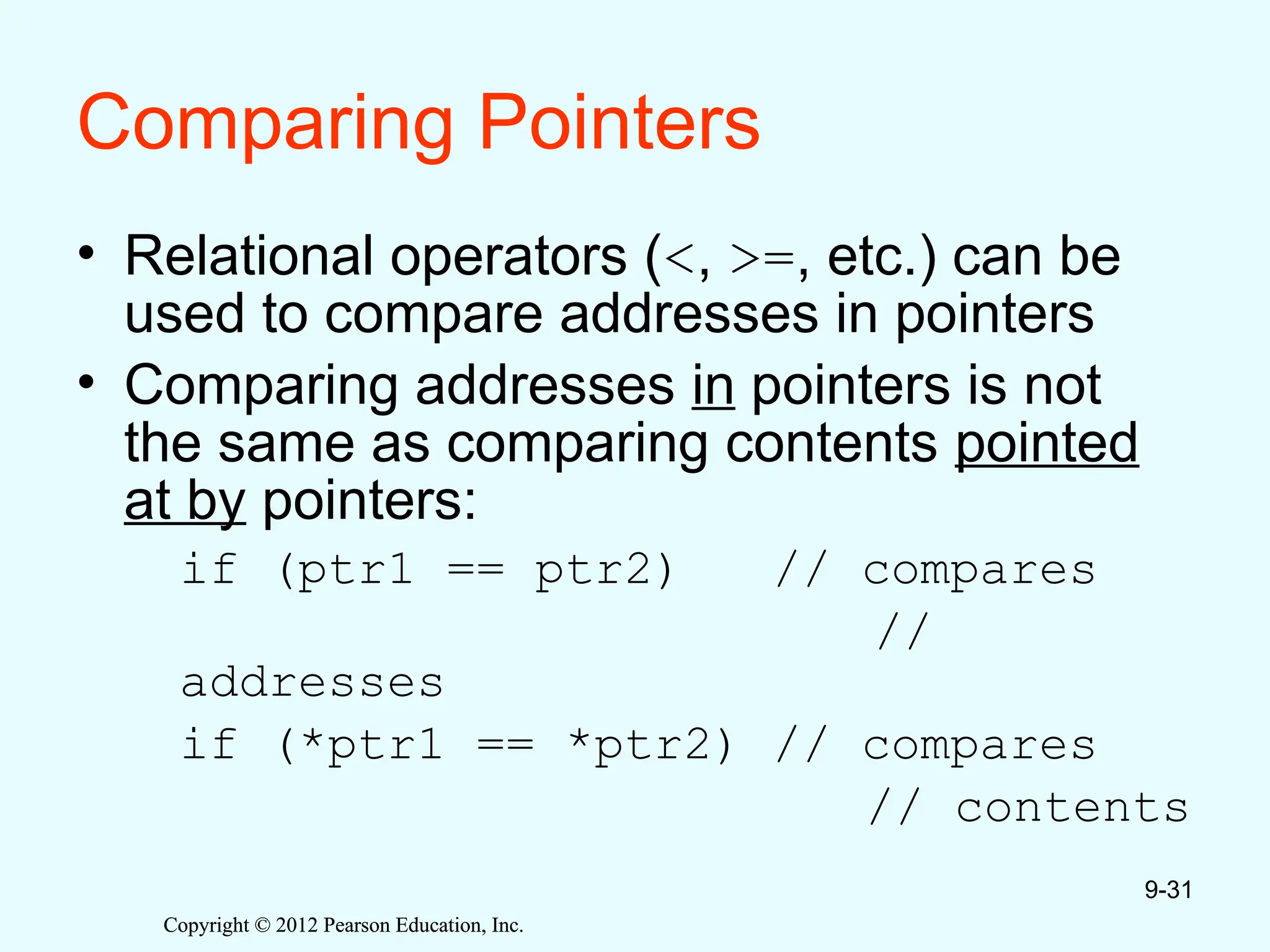

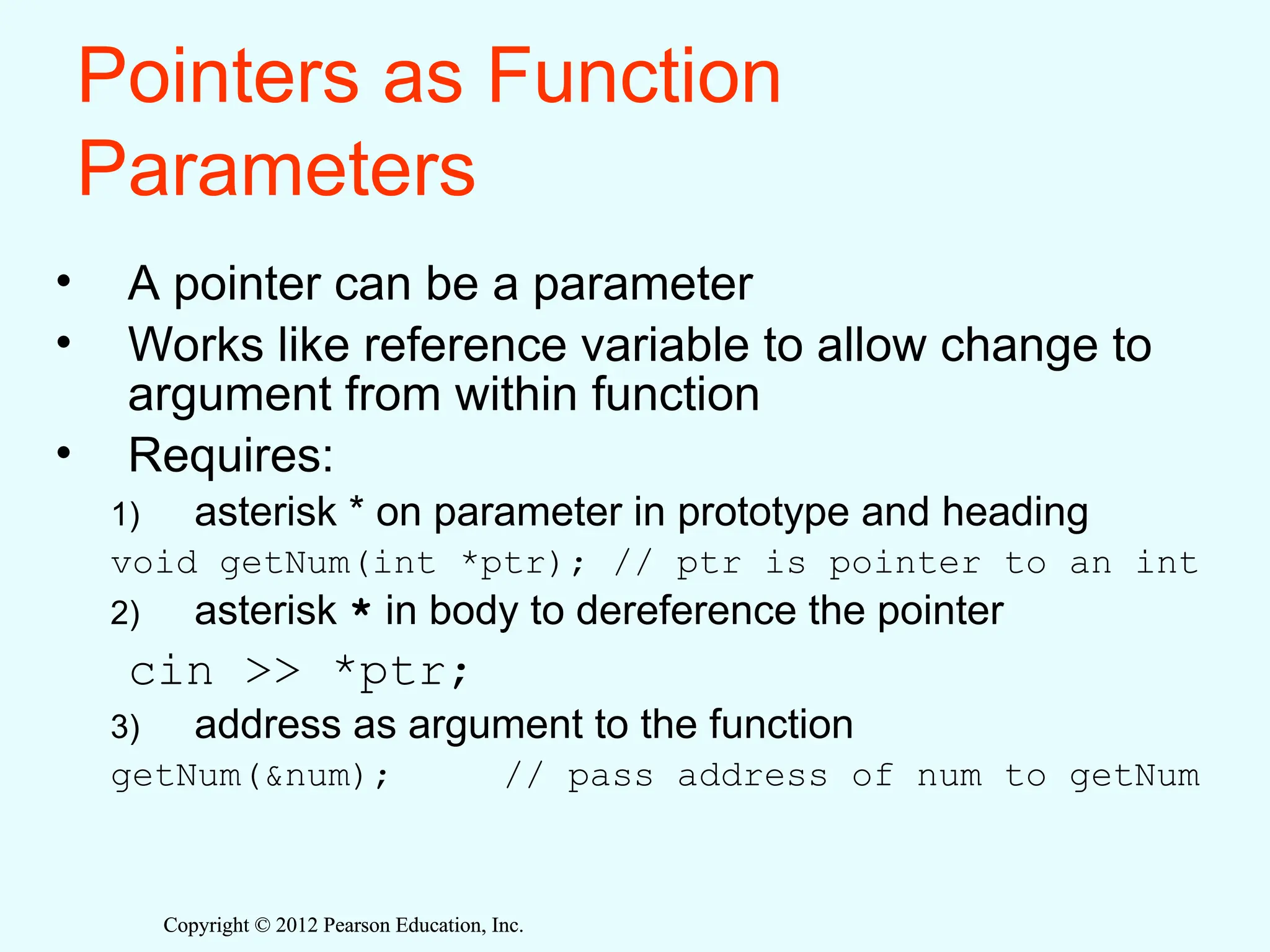

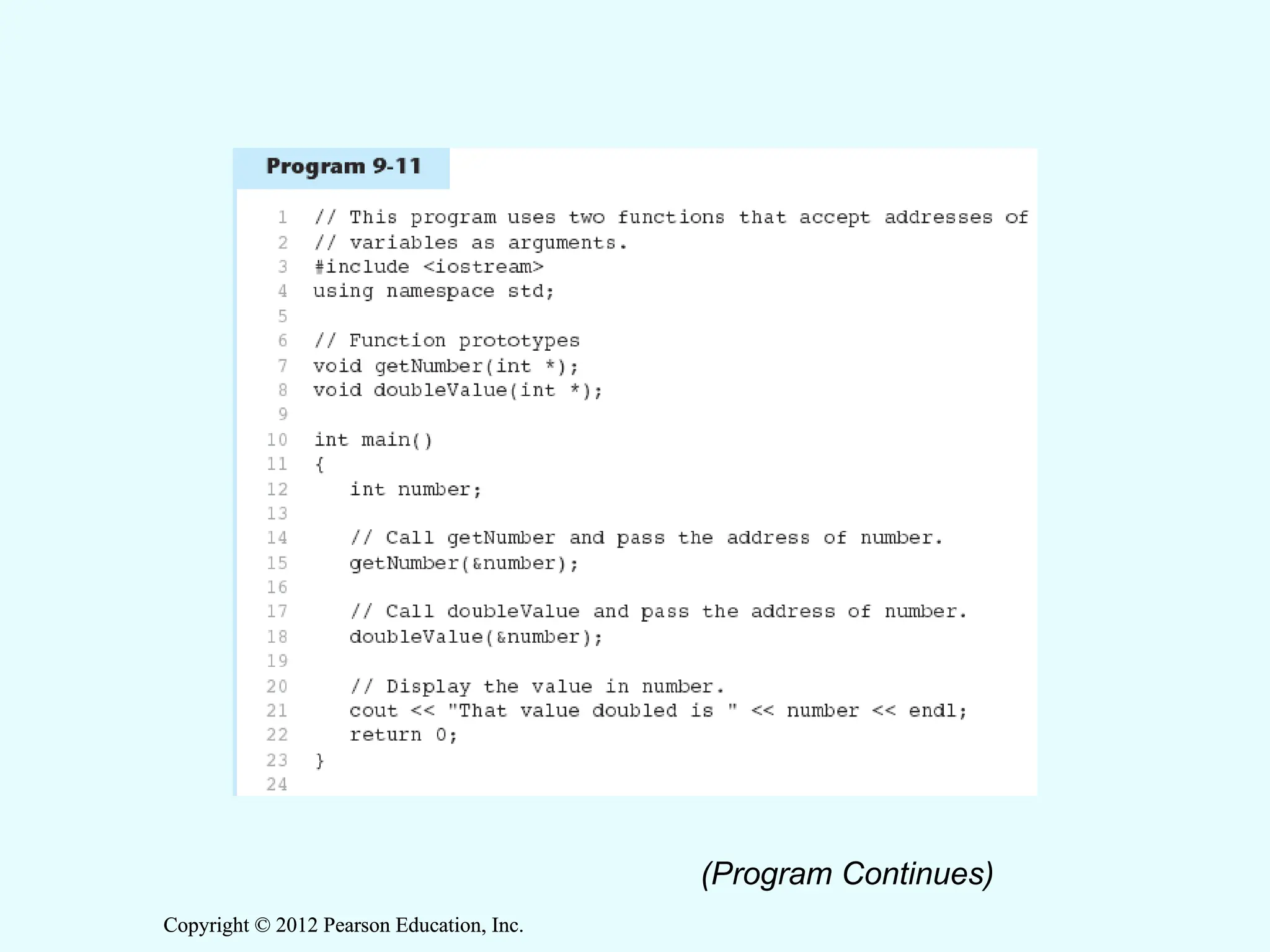
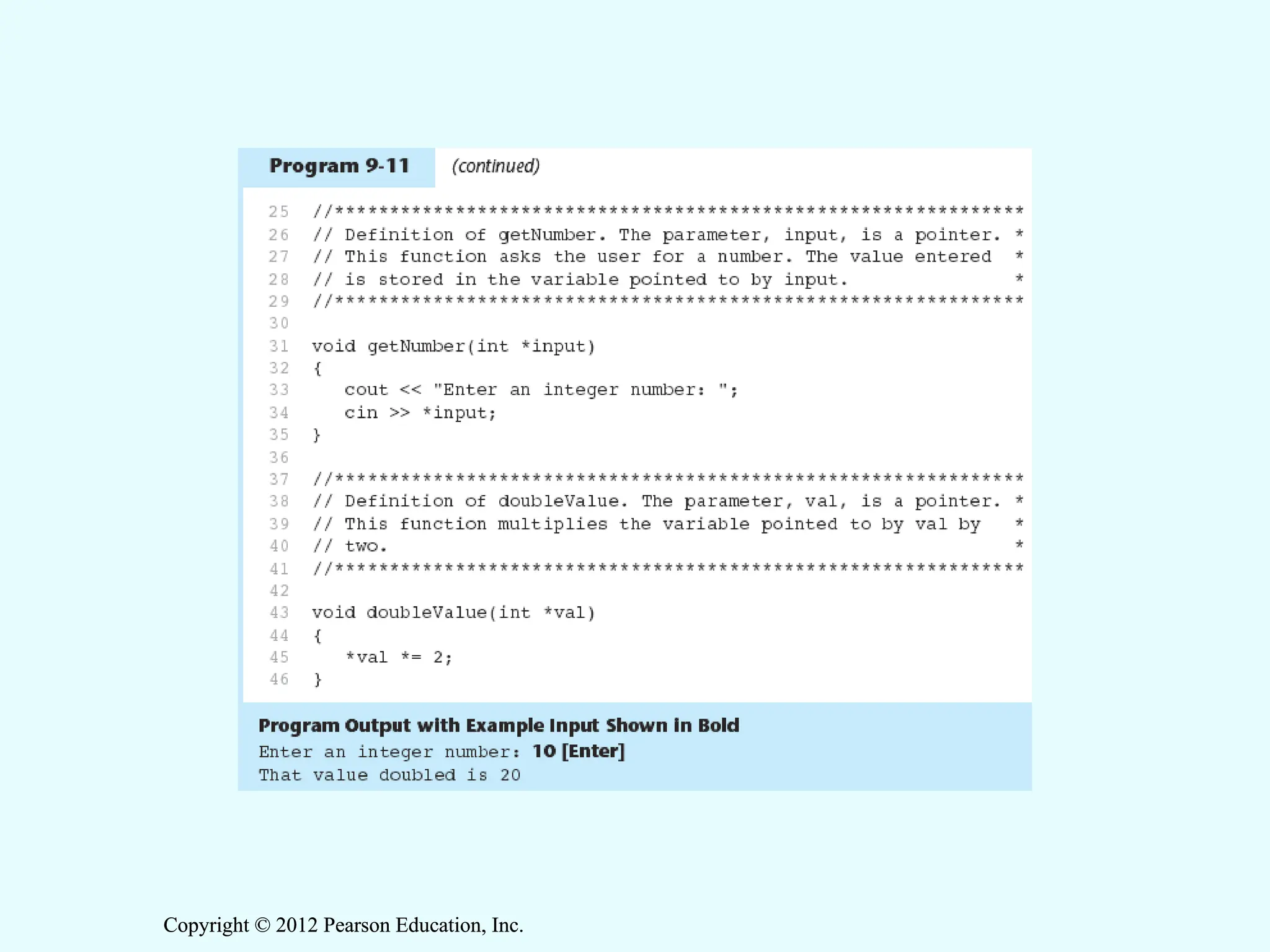
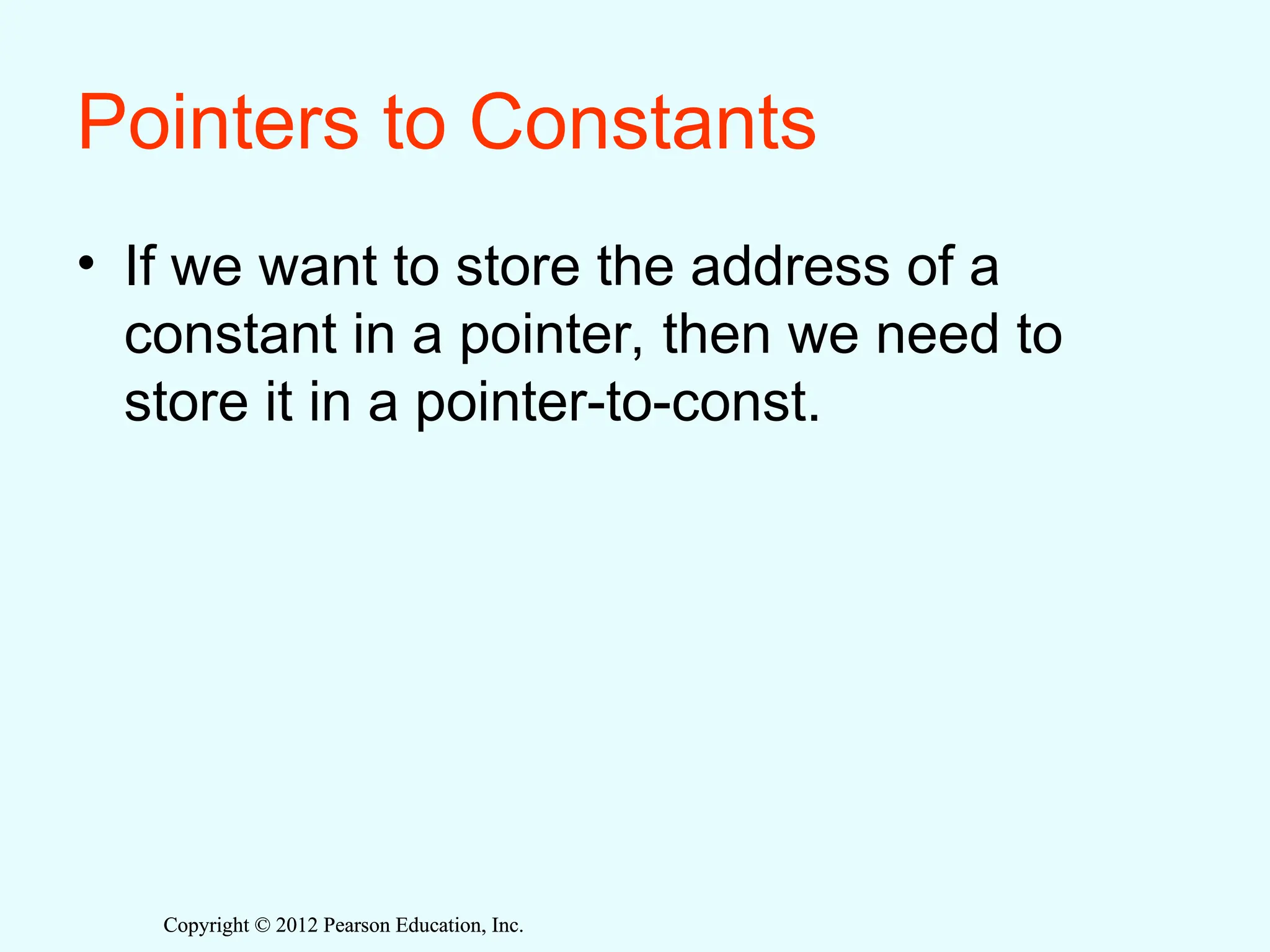
![Copyright © 2012 Pearson Education, Inc. Copyright © 2012 Pearson Education, Inc. Pointers to Constants • Example: Suppose we have the following definitions: const int SIZE = 6; const double payRates[SIZE] = { 18.55, 17.45, 12.85, 14.97, 10.35, 18.89 }; • In this code, payRates is an array of constant doubles. 9-38](https://image.slidesharecdn.com/chapter09-250922172301-bbf49916/75/C-Programming-Text-book-Chapter-09-ppt-38-2048.jpg)

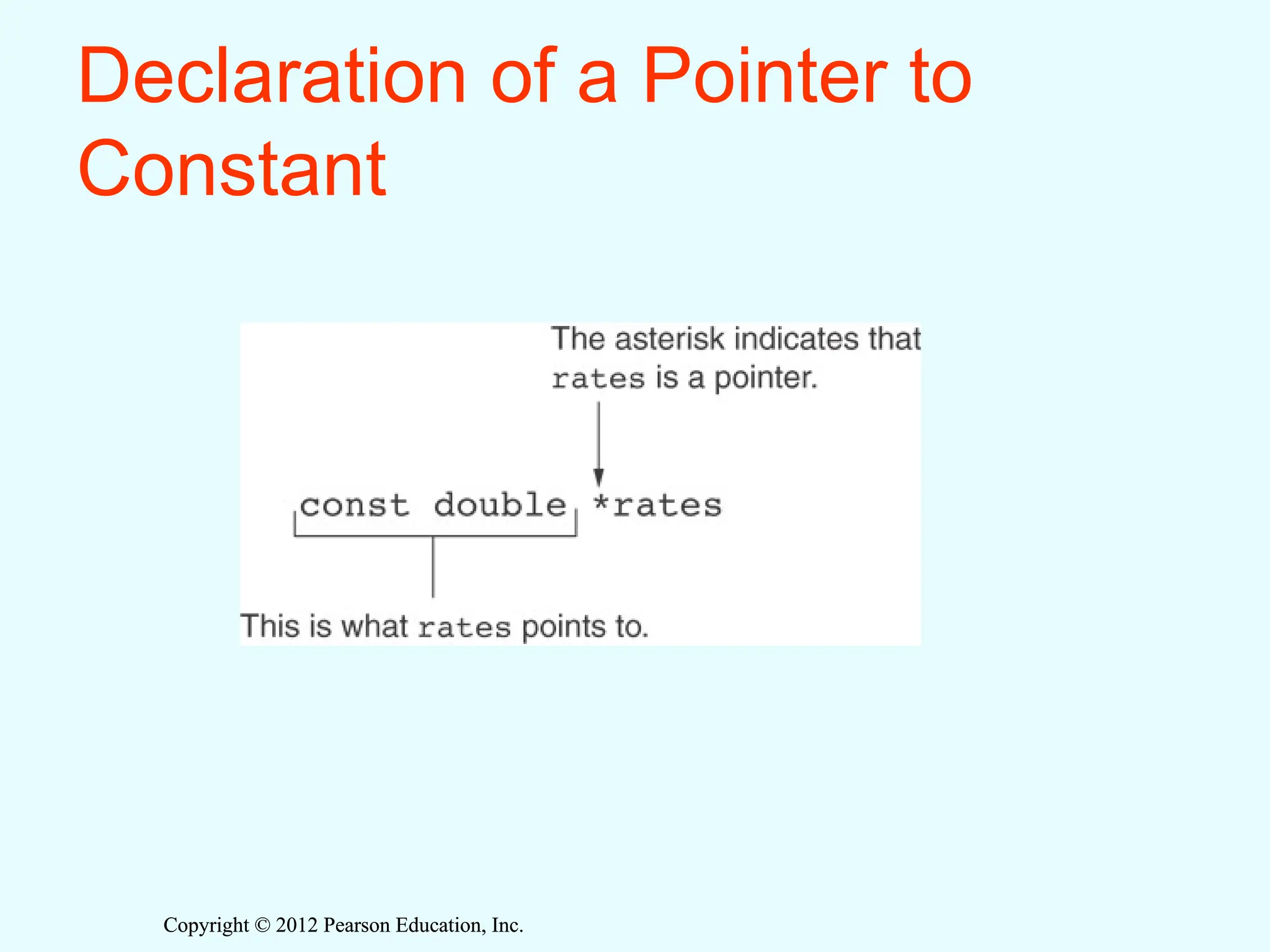

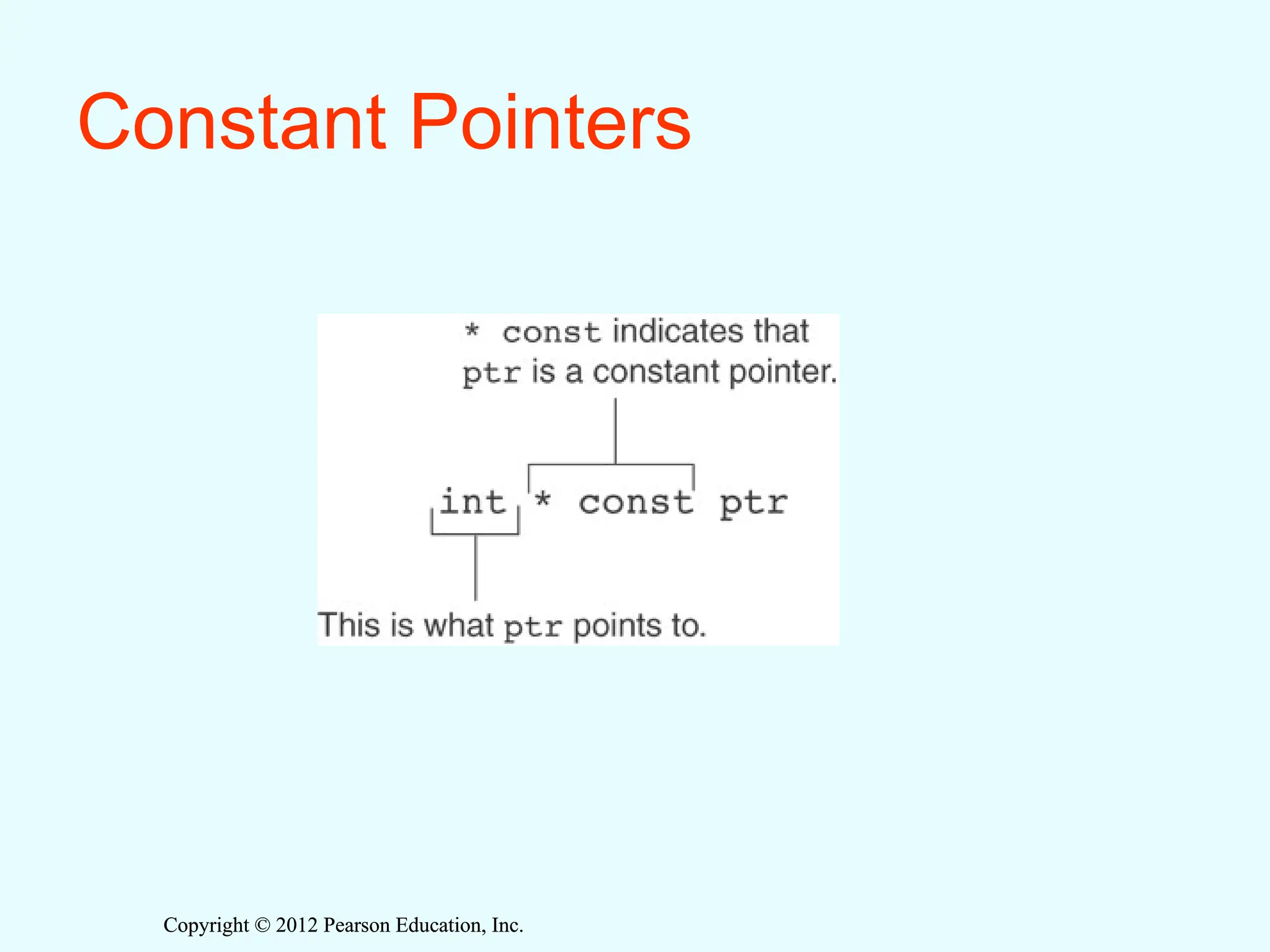
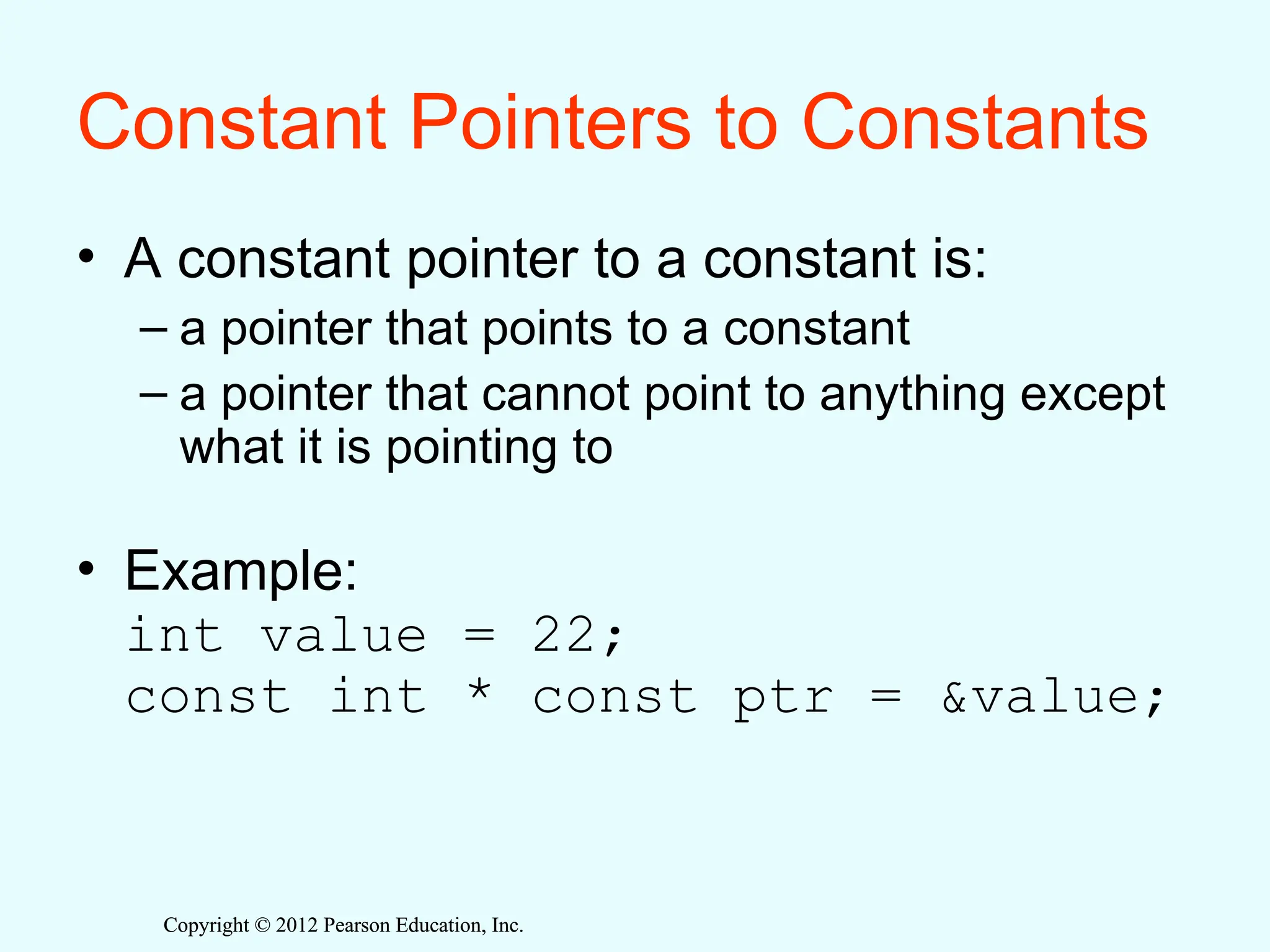


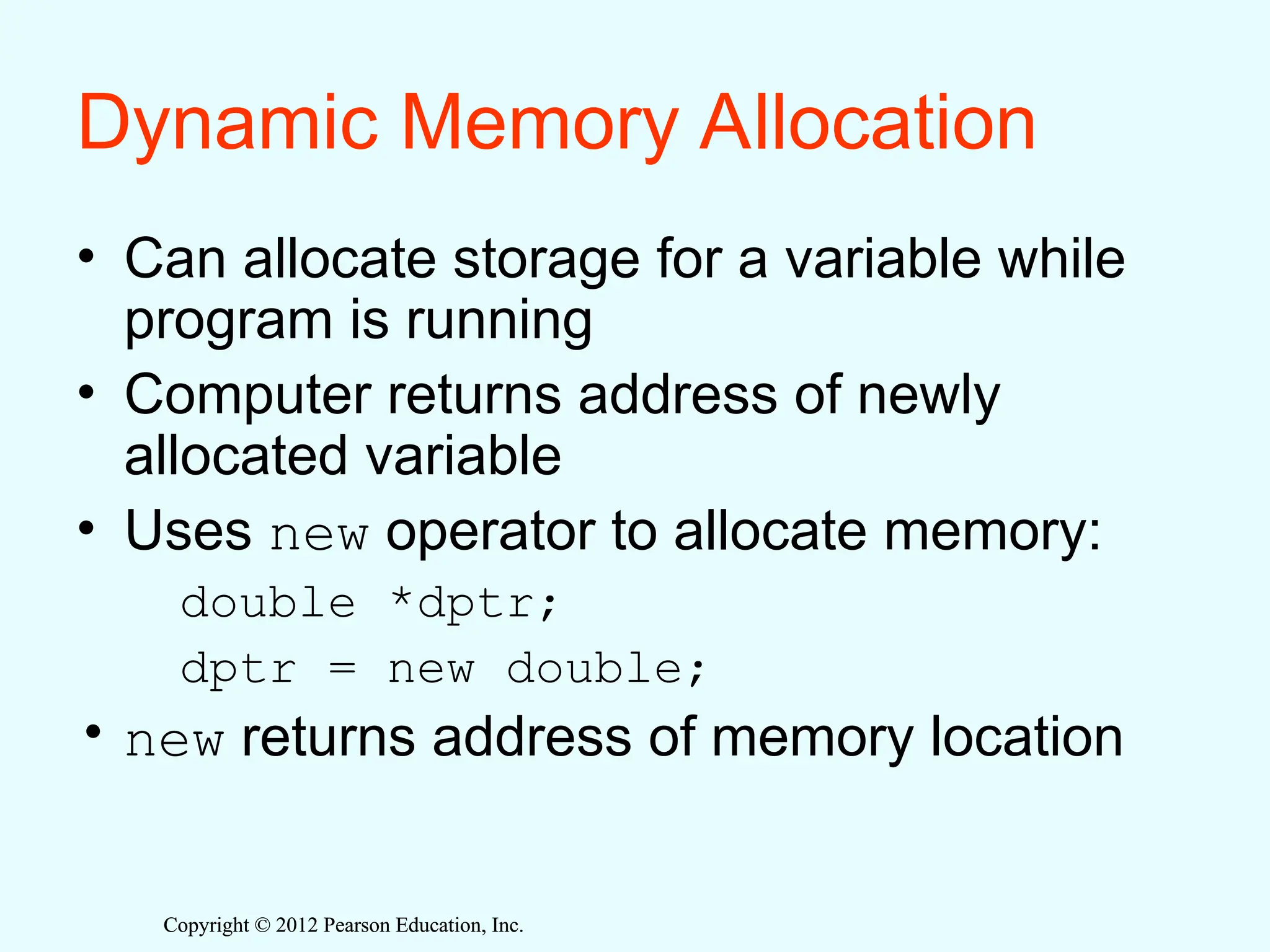
![Copyright © 2012 Pearson Education, Inc. Copyright © 2012 Pearson Education, Inc. Dynamic Memory Allocation • Can also use new to allocate array: const int SIZE = 25; arrayPtr = new double[SIZE]; • Can then use [] or pointer arithmetic to access array: for(i = 0; i < SIZE; i++) *arrayptr[i] = i * i; or for(i = 0; i < SIZE; i++) *(arrayptr + i) = i * i; • Program will terminate if not enough memory available to allocate](https://image.slidesharecdn.com/chapter09-250922172301-bbf49916/75/C-Programming-Text-book-Chapter-09-ppt-47-2048.jpg)
![Copyright © 2012 Pearson Education, Inc. Copyright © 2012 Pearson Education, Inc. Releasing Dynamic Memory • Use delete to free dynamic memory: delete fptr; • Use [] to free dynamic array: delete [] arrayptr; • Only use delete with dynamic memory!](https://image.slidesharecdn.com/chapter09-250922172301-bbf49916/75/C-Programming-Text-book-Chapter-09-ppt-48-2048.jpg)
